Malaysia’s Tourism Recovery Stumbling Behind Regional Neighbours


Nearly a year after reopening its borders, Malaysia is struggling to bring back tourists – especially compared with other Southeast Asian countries.
In the wake of pandemic curbs being rolled back, international visitors haven’t returned in large numbers, and Malaysia’s once-buoyant tourism industry is still largely being kept afloat by domestic travel, according to numerous players in the industry.
Meanwhile, ASEAN neighbours are cashing in on the return of tourists, led by Thailand, Singapore, and Indonesia.
CRUNCHING THE NUMBERS
According to Tourism Malaysia , the country welcomed about 3 million visitors in 2022, a major increase from just 134,728 visitors in 2021. The 2022 intake was only about 12% of the number that arrived in 2019.
However, Thailand, Singapore, and Indonesia — which in 2022 welcomed 10 million, 4.6 million, and 4.58 million visitors, respectively — each saw arrivals return to about 25% of pre-pandemic levels, a notably higher bounce-back than Malaysia’s.
Vietnam’s 3.6 million foreign visitors, although short of the government’s target, was still about 20% of its intake in 2019, well ahead of Malaysia’s 12%.
So what is Malaysia doing wrong?
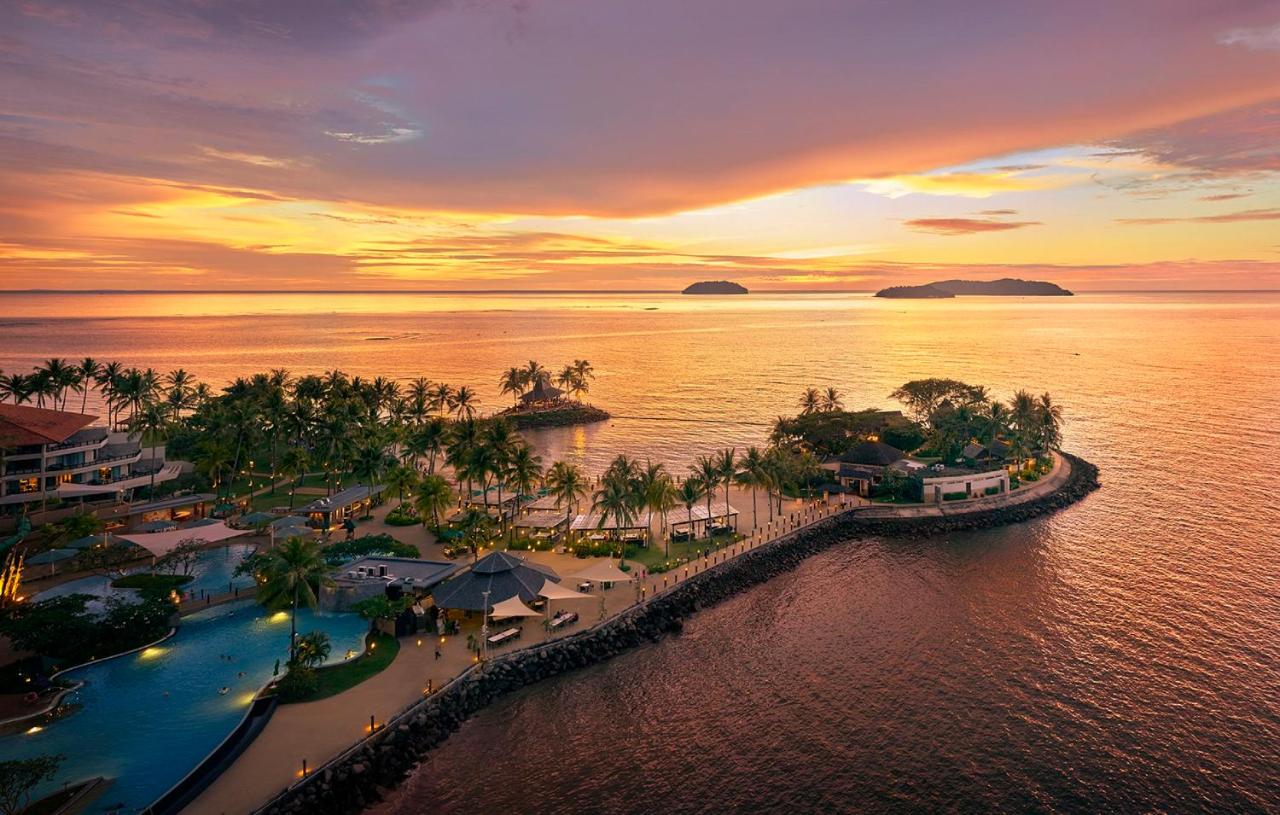
In a series of interviews, as reported by Al Jazeera , tourism industry figures have offered a range of explanations for Malaysia’s weak rebound from the pandemic as compared with its ASEAN neighbours, from poor cost competitiveness to the country’s reputation as a ‘buttoned-up, predominantly Islamic society.’ Unfortunately, despite being afforded the opportunity to weigh in, Tourism Malaysia declined to comment.
Earlier this month, PAS – the Malaysian Islamic Party-backed state government in Kedah, which is home to the popular duty-free resort island of Langkawi – caused no small amount of frustration and set off shockwaves in the tenuously improving tourism sector when they floated a possible ban on alcohol sales, which quickly got picked up by various media outlets.
PAS has since come under some fire for such irresponsible comments, which can often do considerable economic harm despite not actually being anything more than talk, especially when disseminated outside of the country.
Their call for an alcohol ban, coupled with their successful bid to outlaw gambling, led at least one Asian media outlet, the influential South China Morning Post , to erroneously report that alcohol was being banned in Langkawi .
In response to the ensuing kerfuffle, and likely in a bid to mitigate the damage, Kedah Chief Minister Datuk Seri Muhammad Sanusi clarified that the sale of alcohol in Langkawi is under the jurisdiction of the Finance Ministry, not the state government, and further, noted that the state government (PAS) had no authority to interfere with the tourist island’s duty-free status, which Langkawi has enjoyed with no actual problems since 1987.
Similarly, actions by Muhammad Fawwaz Muhammad Jan, a PAS member of parliament, made headlines when he marched into a Penang mall with a few of his supporters and targeted a Chinese New Year festive display and promotion, demanding that the display’s beer cans be removed or concealed. That caused a minor row , ending with the mall’s management inexplicably agreeing to cover everything and close down guest activities at the holiday display, so that “not a single can of beer can be seen at the venue.”
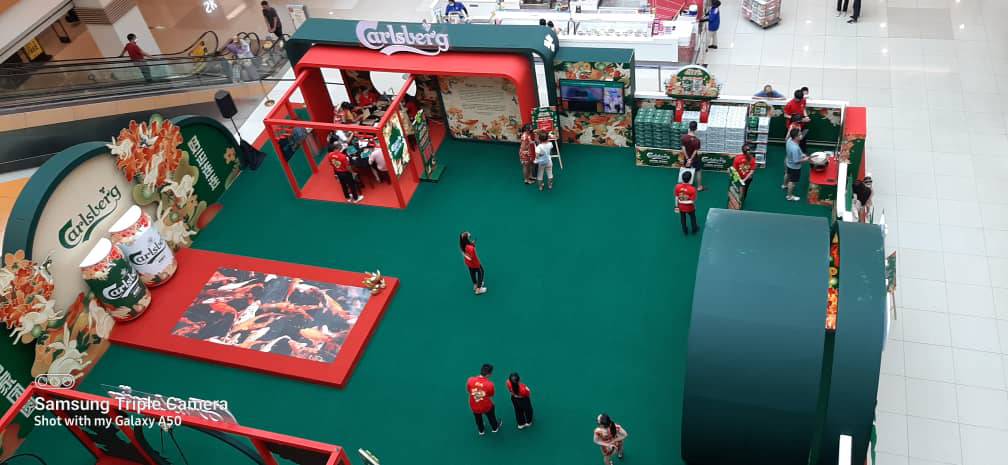
It was frustrating for many, because reports of an ‘ amicable solution ‘ being reached made it sound like a lovely, equitable compromise was reached, with smiles all around, when in fact, Fawwaz got exactly what he wanted – some cheap political publicity and a stop to the promotion of beer – and the mall’s management folded like a cheap card table, even though they had done nothing wrong, and had abided by all laws and regulations at every turn.
The MP was roundly criticised for overstepping his authority and “ assuming the role of moral police ” in his objection to something that is legal, properly licensed and approved, and in line with the rights of the country’s non-Muslims. (Why the mall management capitulated to his demands, then, is beyond belief, as this will only further embolden the issuance of similar demands from PAS in the future in their quest to abolish all alcohol in Malaysia .)
Again, the incident was broadcast through numerous media channels, and once stories like this get outside into the global media sphere, it has the result of making it seem to prospective international visitors that Malaysia is a draconian and intolerant country. Recent other headlines about Melaka’s religious authorities ‘ banning bikinis ‘ at the state’s popular island beaches only serve to reinforce this perception.
As for the ‘war on beer,’ it’s unfortunately not like this should even be big news: Malaysia already has some of the world’s highest alcohol taxes in place, and public spats over all things boozy are a frequent occurrence in Malaysian politics.
Beer magnate Carlsberg, which operates one of the two well-known breweries in Malaysia, cannot even have their brand name on their delivery vehicles, which is why you see large green lorries on local roads bearing only the word ‘Probably’ – part of Carlsberg’s famous tagline , but an odd word to have emblazoned in giant letters on the side of a delivery vehicle.
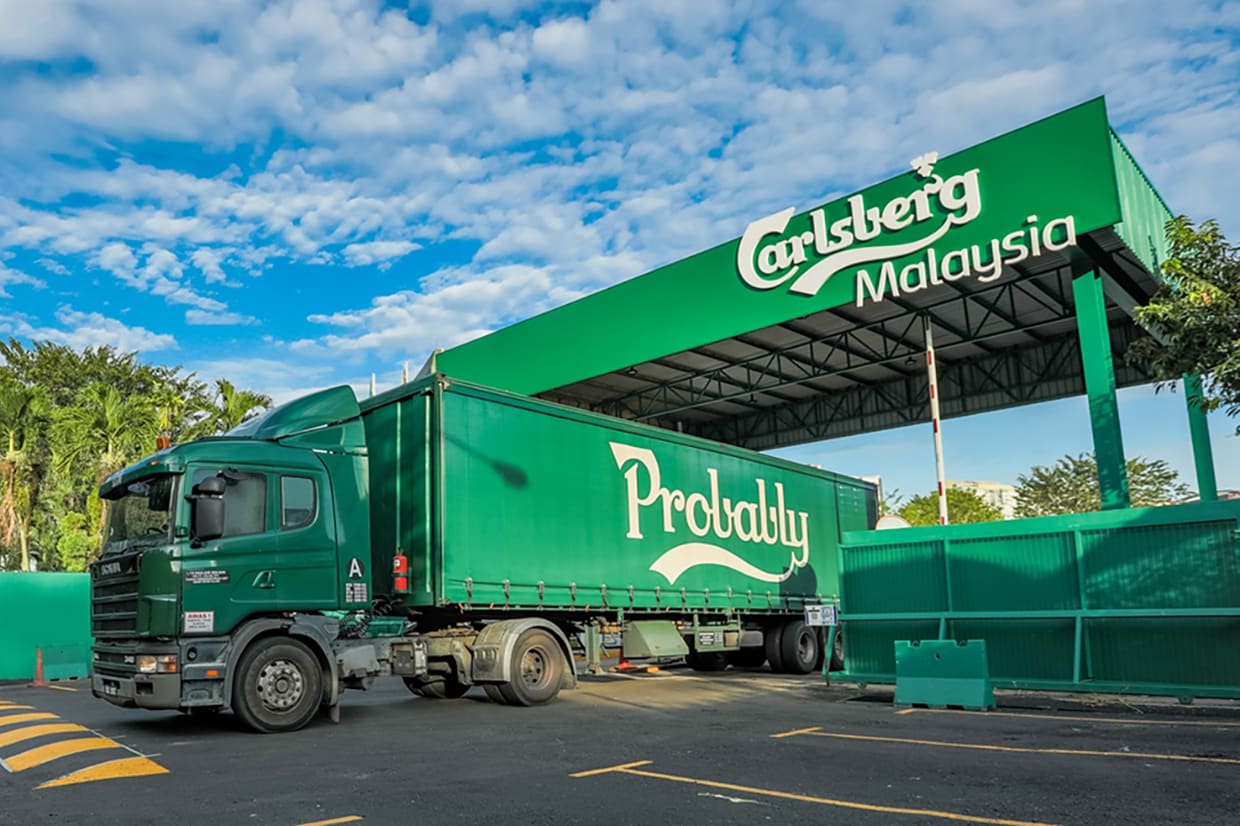
Neighbouring Thailand, on the other hand, has built on its reputation for having a far more tolerant attitude towards vices, even having taken the step of decriminalising cannabis in June 2022.
Another part of the problem, some say, is that Tourism officials lean too heavily on Singapore visitors to prop up Malaysia’s overall international arrivals numbers. In pre-pandemic years, for example, it was common for arrivals from Singapore to make up half or more of all international visitors. Malaysia would cheerfully crow about being in the world’s top 10 for all international arrivals, but in reality, half of those visitors were just coming across the Causeway from Singapore to take advantage of far cheaper goods and services in Johor Bahru.
It’s not that those arrivals shouldn’t count, of course, but it’s disingenuous to compare an arrival from Singapore, who may be visiting and staying with family in Malaysia, or just coming across for a shopping day trip, with a week-long tourist from Europe, the US, Australia, or East Asia. Even if Tourism Malaysia only counts Singaporean arrivals who stay in Malaysia for at least 24 hours, realistically, it’s still just not the same, and lumping in the Singapore-JB crowd with global tourists certainly skews the inbound tourism numbers.
All of this matters because tourism is by no means an insignificant part of Malaysia’s economy. In 2019, according to government reports , tourism industry receipts accounted for just under 16% of the country’s entire GDP, bringing in over RM240 billion, and providing employment for 3.6 million Malaysians, a noteworthy percentage of the nation’s labour force.
INTERNATIONAL TOURISTS CHOOSING OTHER COUNTRIES?
Al Jazeera interviewed tourism veteran Anthony Wong, who we’ve featured on ExpatGo in the past. Wong is considered a pioneer of eco-tourism in Malaysia and owns the Frangipani Resort & Spa in Langkawi.
“From mid-December to mid-March, I used to have 80-90% of clients from Europe,” he said, noting it’s considerably lower now. He speculated that it’s due to a number of factors.
“Flights to Malaysia from Europe are less [frequent] and more expensive, and Langkawi is not as cheap as its neighbours, especially the accommodation. … Europe is also going into recession, with inflation going up, and issues related to the ongoing war in Ukraine make it more challenging for them to spend money on travelling.”
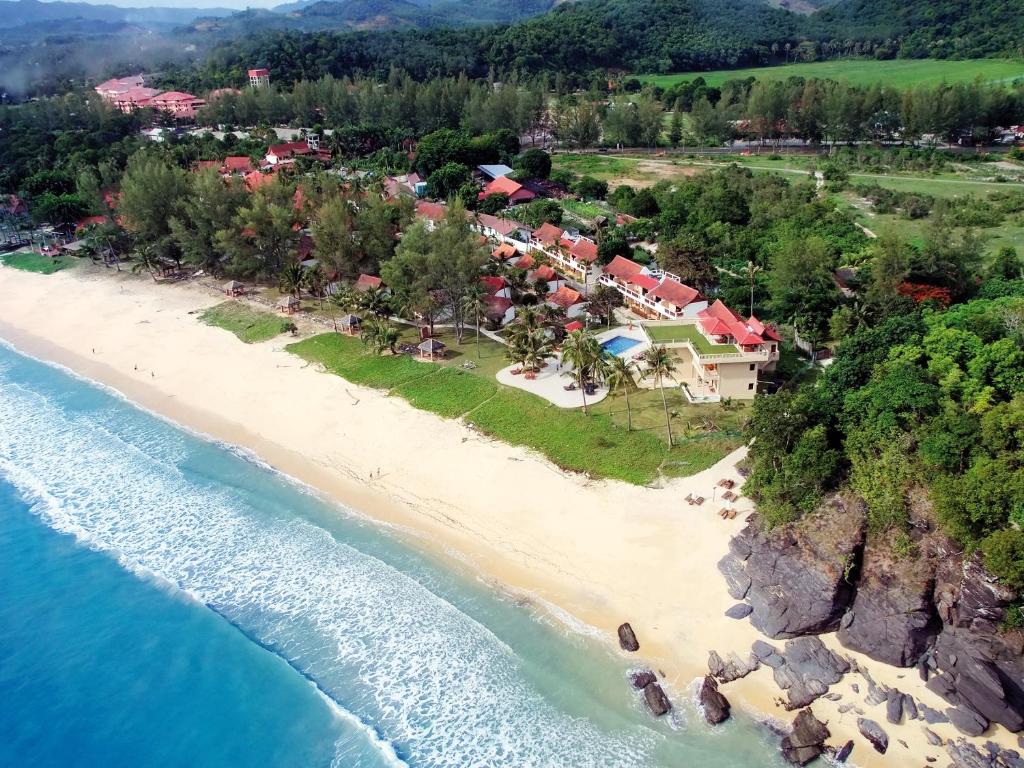
Meanwhile, Arthur Wilkinson, a Penang-born entrepreneur who had a thriving tourism-dependent business in Georgetown, closed up shop for good amid the pandemic as the long-lasting border closure in Malaysia reduced his business to a trickle.
Now, he’s relocated the entire enterprise to Bali to take advantage of their better visitor numbers, and what he describes as a better, more reliable labour force.
“We need to stimulate tourism somehow before it’s too late, as Malaysia is losing massively to Thailand and Indonesia,” he said. “Even though Malaysia has a much wider variety of cuisines, our food and beverage scene and quality isn’t quite up to par compared to our neighbours, which also have lower alcohol tax and are more open to new ideas of tourism.”
COST A FACTOR
When attractions inflate their prices for foreign tourists (as opposed to local visitors), it can backfire and push away the very international visitors the attraction presumably seeks to attract. Seeing a sign with two schedules of fees – one for locals and a much higher one for non-Malaysian visitors – is off-putting, for obvious reasons, coming across as both discrimination and flagrant profiteering.
Just recently, Selangor and the Petaling Jaya City Council have been slammed relentlessly for announcing they would impose a charge for their ‘free bus’ – but only for foreigners , which of course targets the poorest migrant workers and the occasional foreign visitor, as the relatively well-heeled resident expats seldom use the free bus. The disgraceful move has been loudly criticised from all quarters, including human rights groups.
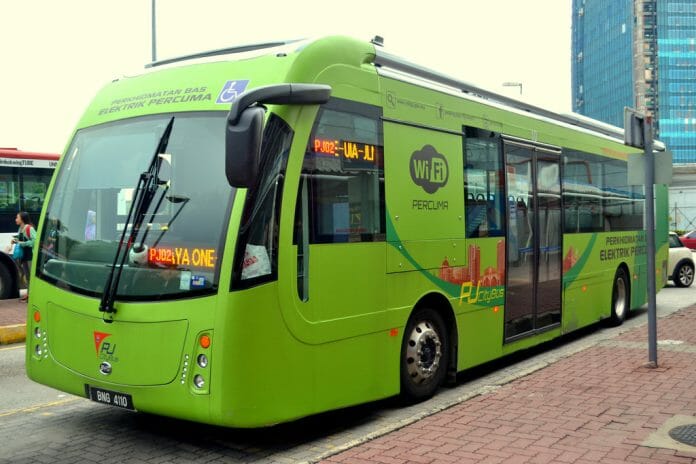
“Trying to build cost recovery solutions on the backs of the poorest and least empowered of customers is really a heartless move by the PJ City Council, so it’s imperative that this measure be rescinded immediately,” said Phil Robertson, the Deputy Director for Human Rights Watch in Asia.
Despite the withering criticism, however, the plan went into effect on January 15, and authorities insist it will remain in place, saying it’s no different than hospital care in Malaysia being subsidised or free for citizens but not for foreigners – an utterly absurd comparison to a free bus service.
Stories like this, as they circulate, get out and create and reinforce the perception that Malaysia is unfriendly to foreigners, and this can lead to obvious problems when it comes to tourism – and even investments by foreigners.
And of course, specifically targeting visitors is even more prone to unintended consequences. Tacking on a per-room, per-night ‘tourism tax’ (applicable to foreigners only) to the already-imposed service and sales taxes at hotels, for one example, can lead prospective visitors to consider other, more wallet-friendly destinations.
Similarly, falling behind in cost competitiveness will usually not work out well. A Malaysian resort who puts up its rates above those of similar-class properties in neighbouring countries, for instance, may make a bit more per guest, but the total number of guests will likely fall below that of the competing resort over time.
Pricey Langkawi accommodation has come under scrutiny for this very phenomenon, not least by Malaysian travellers. “Why would my family pay hundreds of ringgit each to fly to Langkawi, then pay RM400-500 a night for a decent hotel when we can pay less to have the same holiday in Phuket – and with better food and better beaches?” one local traveller explained.
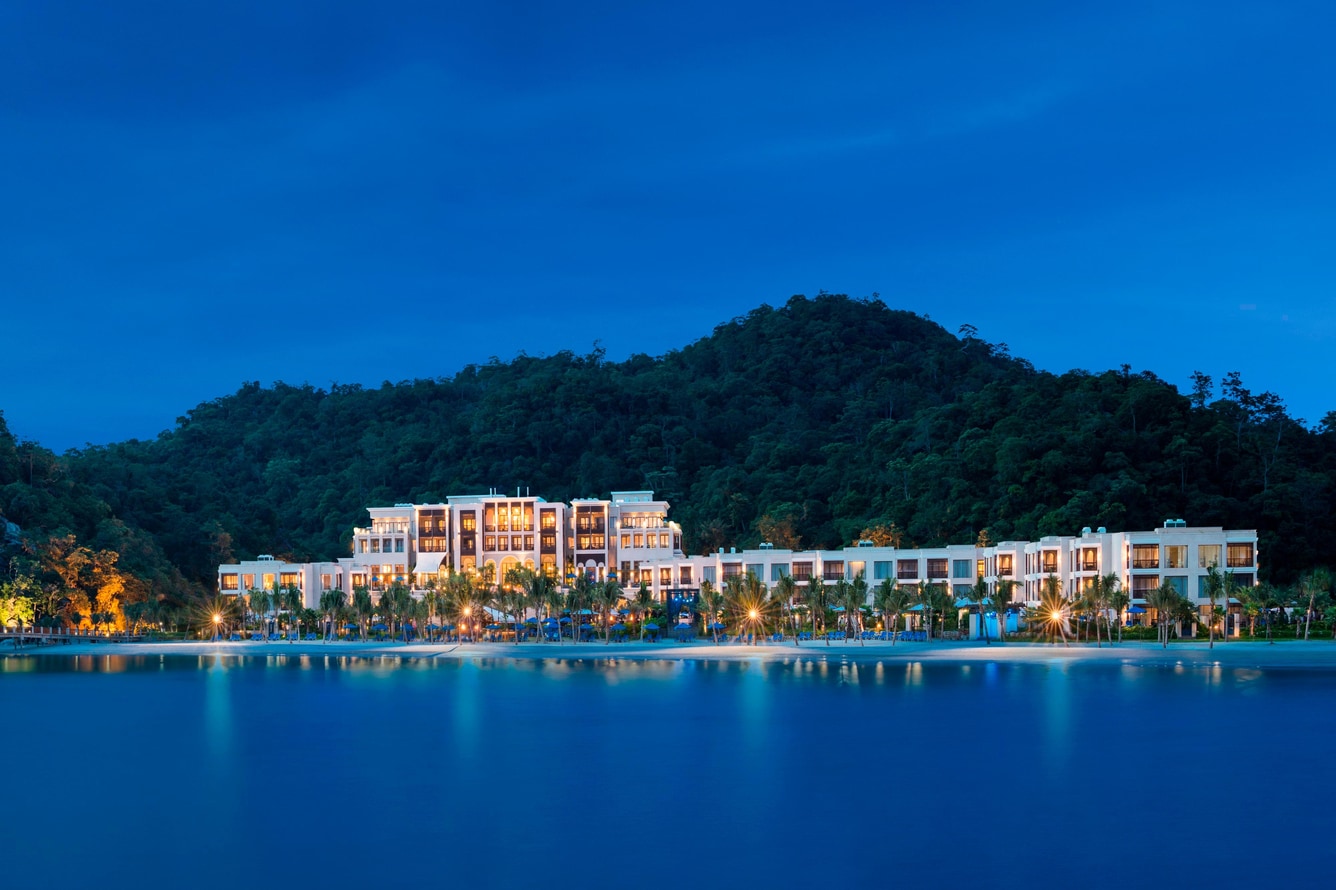
Over in East Malaysia, which so far has actually enjoyed a better recovery overall than the Peninsula, struggles with cost competitiveness, as well.
For those with less to spend, travel and accommodation costs in Sabah and Sarawak, which are at their highest in years, could be a deterrent.
“Most lodges and transport providers introduced a hike of up to 20%, while government agencies such as Sabah Parks doubled the price of some permits and entrances,” said Jessica Yew, who is the director of Kota Kinabalu-based boutique tour company Sticky Rice Travel.

The sharply higher prices in East Malaysia include permits to climb to the summit of 4,095-m Mount Kinabalu, which just doubled from RM200 to RM400.
According to the Al Jazeera report, when adding up the costs of permits, guides, food, and accommodation, the cheapest packages to tackle the lofty summit come to about RM2,300 per person.
Another major draw for Malaysian Borneo is of course its famed orangutans. But prices have risen so sharply, tour operators actually send prospective visitors to Indonesia instead.
“I tell people to go to Sumatra to see orangutans,” one said, “as it costs one-third to one-fifth of Malaysian Borneo’s prices.”
A LONG-TERM, SUSTAINED STRATEGY IS NEEDED
A lack of consistency and implementation in tourism promotion has also been mooted as part of the problem.
“Malaysia does not lack attractions, especially natural ones. Tourism development suffers from inconsistent policies and promotional activities over the past decades,” said Fabio Delisi, who has more than 30 years of experience in tourism across the region, and runs inbound tour operator Lotus Asia Tours. “Tourism is a very long-term public relation exercise.”
Delisi, whose company also operates in Indonesia and Singapore, remarked to Al Jazeera that Malaysia’s fortunes have stood in stark contrast to those of Indonesia – and not just in the last year.
“We are wholesalers operating in Malaysia, Indonesia, and Singapore since the early 1990s, and in 2022, have experienced a decline of arrivals of up to 90% from our main Western markets into Malaysia, while we have seen double-digit growth in Indonesia for the same period,” he said.
“We are paying the price for more than 20 years of random policies without focus and continuity,” he noted, highlighting the need for a framed, coordinated, and consistent strategy over time to grow inbound tourism.
Interestingly, when perusing Tourism Malaysia’s own marketing plan (2022-2026) , authorities here name these problems among the country’s weaknesses, too, specifically poor cost competitiveness, lack of advertising, and inadequate uniform communication. There also seems to be a strong push on growing domestic tourism, which while not undesirable as part of a broader effort to strengthen the country’s tourism sector, doesn’t do as much for the country’s recovering economy as bringing in foreign tourist dollars.
Reporting from Al Jazeera, New Straits Times, Malaysia Now, and SCMP contributed to this article, as did published reports from the Malaysia Ministry of Tourism.
Most Popular

Calling All Expat Entreprenuers!

Burning Up the 5G Superhighway: Malaysia’s Speeds Are Second-Fastest in Asia Pacific
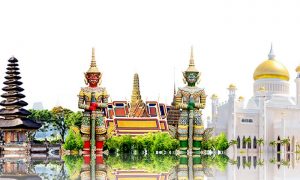
AirAsia Shifts Focus to Southeast Asia Region with New ASEAN Explorer Pass

Langkawi Wraps Up the 20th Edition of Its International Regatta in Fine Fashion

Refresh Your Music with Heineken!

Forest City’s Parent Company, Country Garden, Likely to Face Trade Suspension in China
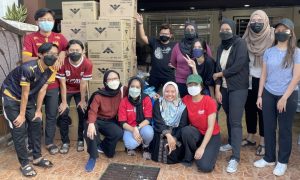
RaiseTogether Launches a ‘Swift’ New Charity Campaign
Malaysia’s tourism recovery flops as Thailand, Indonesia cash in
Malaysia is struggling to bring back tourists compared with its Southeast Asian peers after scrapping pandemic curbs.
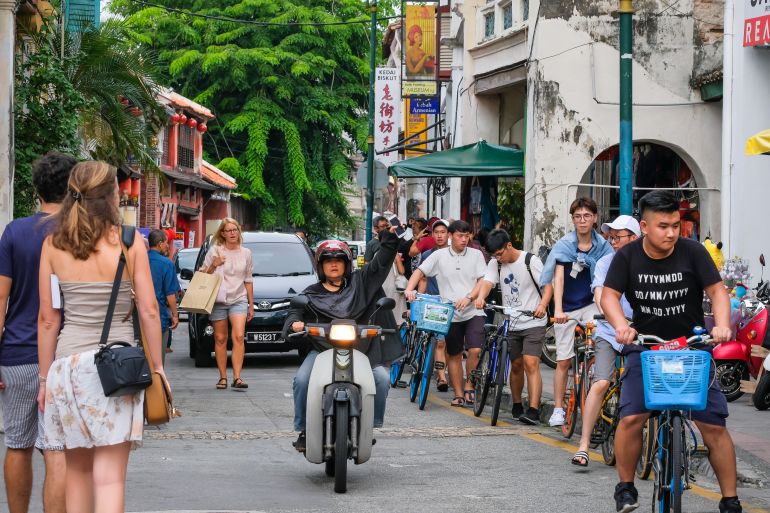
Kuala Lumpur, Malaysia – For Arthur Wilkinson, a Penang-born entrepreneur who opened Malaysia’s first flotation therapy centre on his tropical island home, nearly two years without tourists marked the end of the road.
Float For Health, located in Tanjung Tokong, a coastal township on the northeastern side of Penang island, shut up shop for good in January 2021 as border restrictions introduced to keep out COVID-19 reduced customers to a trickle.
Travel Distribution
Covid: malaysia's tourism sector faces collapse.
Since the beginning of the pandemic, tourism in the Southeast Asian country has plummeted. The consequences are dramatic for those who work in the industry.
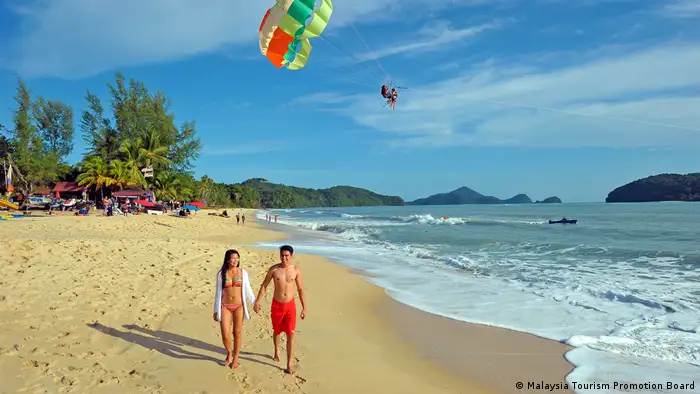
The Malaysian economy is suffering from lack of tourists
Kira, who prefers to not disclose her full name, usually rents out vacation homes in Kuala Lumpur. Before COVID-19 it was a thriving business. After all, her home country is not only known for its rainforests, gorgeous beaches and picturesque islands — travelers have long been drawn to its capital, Kuala Lumpur. Among the city's most popular attractions are the famous 451-meter-high (1230 ft.) Petronas Twin Towers.
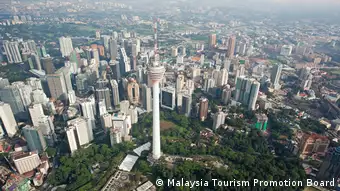
Before the pandemic, many tourists visited Malaysia's capital, Kuala Lumpur
But instead of the hoped-for influx of tourists , the first wave of the COVID-19 pandemic came in 2019. Since then, things have looked rather bleak for Kira, as well as for many of the 3.5 million people in Malaysia who depend on the tourism industry. "I have hardly any bookings and when I do, it's only for a few days. These are mostly business people or some locals who might be visiting family in town," she tells DW. Before the pandemic, her apartments were always fully booked. More than a year ago, the 28-year-old had to move back in with her parents to avoid paying rent.
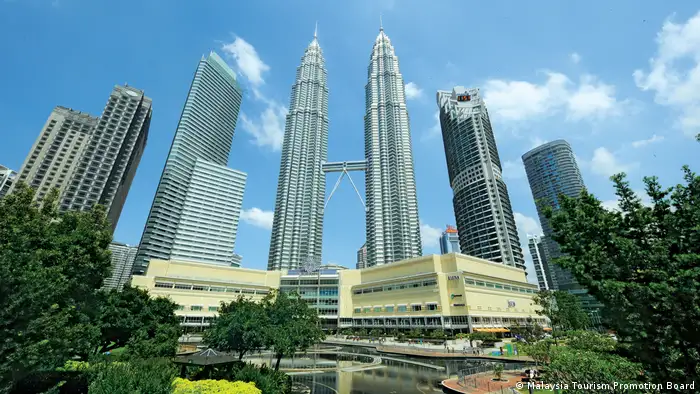
The Petronas Twin Towers are one of the main attractions of Kuala Lumpur
Supporting women
Young women like Kira in particular are suffering from the impacts of the pandemic in the Muslim country, according to the Minister of Tourism, Arts and Culture, Datuk Seri Nancy Shukri. This is also evidenced by the 2020 analysis by the International Labor Organization, which shows that more female workers in the tourism sector have lost their jobs worldwide than men.
In Malaysia, the number of women working in the tourism industry dropped by more than 2% to 48.3% in 2020, compared to 50.3% in 2019, and the Malaysian government has announced that the 2022 gender-balanced budget will benefit women in tourism equally. To ensure that the tourism industry will eventually recover and be additionally improved, the Malaysian government intends to continue implementing support measures in the future.
"The umbrella framework for this is Malaysia's National Tourism Policy 2020-2030, which is based on the three pillars: Competitiveness, Inclusion and Sustainability," Nancy said.
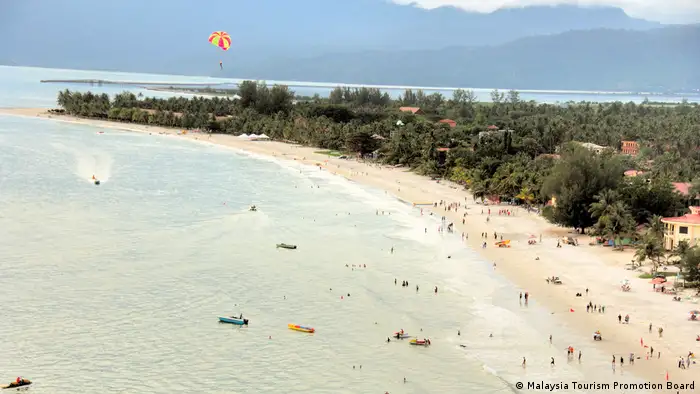
Langkawi is one of Malaysia's most popular islands with tourists
The Langkawi pilot project
On November 15, the Malaysian government opened the popular vacation island of Langkawi to fully vaccinated international tourists without the need to quarantine. It was the first destination in Malaysia to do so. Tourism Malaysia is also working with international airlines to restore Malaysia's long-dormant connections. Malaysia Airlines currently flies twice weekly from London to Kuala Lumpur until the end of December 2021. The frequency is scheduled to increase to five times weekly between January and March 2022.
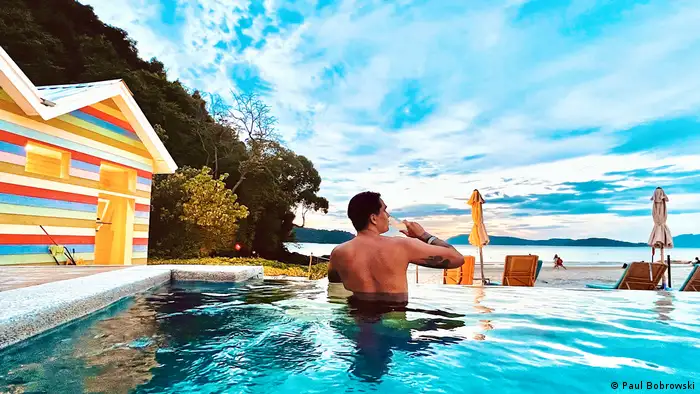
Those relying on the tourism industry in Malaysia hope for the return of foreign tourists
Although tourism on the island is slowly coming back to life — resorts, hotels, bars and restaurants are open again — the rush of international tourists has so far failed to materialize, despite the well-intentioned measures. There are few tourists to be seen in Kuala Lumpur, but there are foreigners living in the city for work. For locals working in the tourism sector on the Malaysian vacation island, it's a drop in the ocean.
Shaun (not his real name) works for a businessman who rents out small villas on Langkawi to tourists. For the past 1.5 years, however, virtually nothing has been happening here either. Many businesses, especially small ones, have had to close. Shaun is glad that his boss has taken money in hand and used the time of the lull to carry out renovation work, he tells us.
But now, tourists must finally come again, otherwise, things will look bad, the young man says. Many of his friends have lost their jobs and have to see how they can make ends meet. Shaun and other affected people are now hoping for the announced government measure.
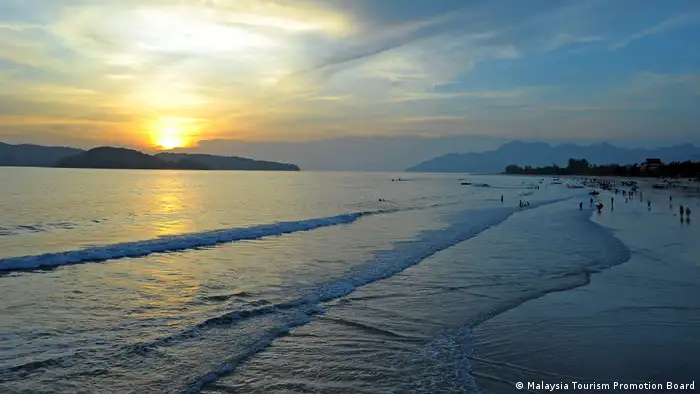
The Malaysian government has taken steps to encourage tourists to return in 2022
Hoping for foreign tourists
The Southeast Asian country plans to reopen its borders to international visitors starting January 1 in a bid to revive its ailing tourism sector. While the country has gradually reopened its economy in the face of declining COVID-19 cases, the tourism industry is simply recovering too slowly without foreign visitors, according to National Recovery Council Chairman Muhyiddin Yassin. In Malaysia, 94.9% of adults are already fully vaccinated, based on statistical surveys. It is hoped that the next wave of the virus will not occur after the borders have been opened and that things will finally start to look up again. Malaysia is currently represented at all tourism trade fairs — especially in Europe — in order to promote itself. Yet difficult times may be ahead.
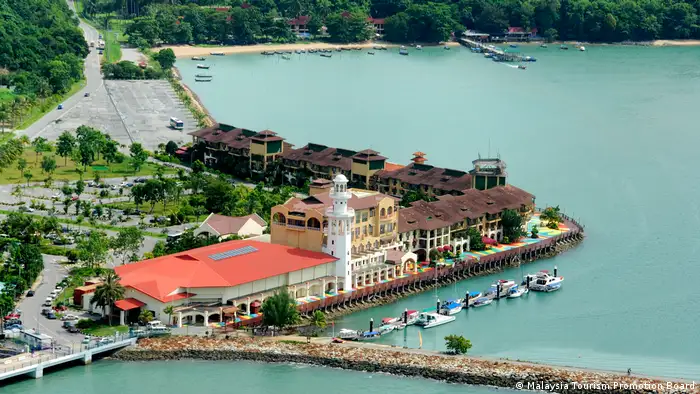
Langkawi became the first destination in Malaysia where vaccinated tourists didn't have to quarantine
New COVID-19 variant poses risks to tourism
Malaysia has temporarily banned entry from countries that have recorded cases of the omicron COVID-19 variant or are considered high risk, Health Minister Khairy Jamaluddin said on December 1. The Southeast Asian nation joins countries around the world in doing so. If it stays that way and the borders are not opened soon as planned, experts say Malaysia's tourism industry faces a complete collapse from which the country would likely struggle to recover.
Nevertheless, those affected are not giving up hope and remain true to their motto "Malaysia Boleh!" which, loosely translated, means something like "Malaysia can do it." But since the advent of COVID-19 pandemic, this phrase has acquired an almost sarcastic edge.
This article was originally written in German.
- Date 06.12.2021
- Author Linda Bethke
- Feedback : Send us your feedback.
- Print Print this page
- Permalink https://p.dw.com/p/43smH
- Send us your feedback.

Carla Hagemann
Corporate Spokesperson and Head of Corporate Communications
T +49.228.429.2042
- TOP STORIES
- Environment
- A - Z Index
- LEARN GERMAN
- Community D
- Teaching German
- Business & Sales
- Regional Reception
- Digital Offers
- Newsletters & Co.
- All FAQs about DW
© 2024 Deutsche Welle | Privacy Policy | Privacy Settings | Accessibility Statement | Legal notice | Contact | Mobile version

MALAYSIA’S NATIONAL TOURISM POLICY: FOCUS ON RECOVERY, CONNECTIONS, AND SUSTAINABILITY

In late December 2020, the Prime Minister of Malaysia launched Malaysia’s National Tourism Policy 2020-2030, giving concrete direction for the future of Malaysia’s tourism industry over the next ten years.
In his speech, the Prime Minister emphasised the importance of recovery, connections, and sustainability. In the challenging period that we are facing right now and the limitations imposed upon us by the pandemic, these are the core actions we must all embrace, regardless of whatever industry we are in.
These three core ideas are emphasised further through the National Tourism Policy’s six transformational strategies namely:
- Strengthen governance
- Create special tourism investment zones
- Embrace smart tourism
- Enhance demand sophistication
- Practise sustainable and responsible tourism
- Upskill human capital
At Islamic Tourism Centre (ITC), we fully align with these concepts as well, understanding that we need to continue our efforts to revitalise the tourism sector with the best possible preparation. Insha Allah, our efforts now are to prepare for a time later when the availability of effective vaccines and the opening of borders can boost travel again.
To move us forward, ITC has embraced the philosophy of “New thinking, new actions, new results.” With this shift in perspective, we are more focused on engaging with key influencers, deepening our relations with industry players, and strengthening our ITC brand locally and internationally.
Under the National Tourism Policy, Muslim-friendly tourism has been given a priority as well with the aim of cementing Malaysia’s position as the global leader in an alternative and ethical form of tourism beyond rituals. Towards this end, ITC has been tasked to consolidate Malaysia’s position as the world’s top destination for Muslim-friendly travel by increasing the depth of Islamic hospitality.
ITC aspires to fulfil these goals through five key actions:
- Creating smart partnerships with related agencies to establish Malaysia as the global centre for Muslim-friendly hotel certification
- Positioning ITC as the leading repository of market intelligence and reference centre for Muslim-friendly tourism and hospitality
- Branding Malaysia as the top venue for Islamic contemporary lifestyle through conferences, fashion shows, art and calligraphy exhibitions, and gastronomy festivals
- Leveraging on Islamic principles as the foundation to raise the service quality of Muslim-friendly hotels
- Establishing smart partnerships between ITC and the Ministry of Health and the Malaysia Health Travel Council to turn Malaysia into a front-runner in Islamic healthcare and wellness.
Related Posts

ISLAMIC TOURISM CENTRE RETURNS TO THE ARABIAN TRAVEL MARKET 2024 TO CAPTIVATE THE MIDDLE EAST REGION

EMPOWERING PULAU PINANG BUMIPUTERA IN THE MUSLIM-FRIENDLY TOURISM AND HOSPITALITY (MFTH) SECTOR
Memperkasa bumiputera pulau pinang di sektor pelancongan mesra-muslim dan hospitaliti (mfth).
Lost Your Password?
Reset Password

- DEAN'S OFFICE
- RESEARCH, INNOVATION AND POSTGRADUATES
- GALLERY SERDANG
- STUDENT GUIDE
- FACULTY ACTIVITIES

https://ttsreader.com/ https://www.naturalreaders.com/online/

The two main activities prohibited during the COVID-19 pandemic are movement and congregation – these are the two exact words that define tourism. UNWTO’s World Tourism Barometer indicated that tourism arrivals fell from 1.47 billion in 2019 to 399 million in 2020, signifying a 74.0 per cent decrease worldwide.
Prior to the pandemic, Malaysia’s economy was highly dependent on tourism, which was the third largest contributor to national GDP at the time, after manufacturing and commodities. In perspective, 2019 brought 25.83 million tourists, generating RM 84.1 billion in tourist receipts for Malaysia. The Gross Value Added of Tourism Industries (GVATI) further accounted for 9.1 per cent or RM240 billion of the country’s GDP in 2019.
Based on these statistics, Malaysia envisioned becoming the leading tourist destination through its Economic Transformation Programme and targeted to receive 30 million tourists and RM100 billion in tourist receipts in conjunction with Visit Malaysia 2020.
On 18 th March 2020, all these aspirations came to a complete stop.
As a result of the Movement Control Order (MCO) and the closure of international borders, Malaysia’s tourist receipts contracted by 85.3% from RM86.14 billion in 2019 to a mere RM12.69 billion in 2020. The Companies Commission of Malaysia (CCM) reported that in 2020, 204 tourism-related companies were forced to shut down, including 109 hotels and short-term lodgings and 95 travel companies that ceased operations. The airline industry, meanwhile, incurred losses worth RM10.9 billion. Though Malaysia was not alone in registering negative growth in 2020 as a result of closing its borders, that year was deemed Malaysia’s darkest year for tourism.
So, where are we today?
Malaysia’s travel sector has seen gradual growth in domestic tourism since the relaxation of inter-district and inter-state travel restrictions. Even though Malaysia’s international borders officially reopened on 1 st April 2022, it will take at least three years for tourism in Malaysia to return to pre-pandemic levels. On the bright side, the break from mass tourism has significantly reduced the anthropogenic ill-effects of tourism and its related activities on the environment, paving the way for the re-opening of borders to attract a niche of tourists seeking safe, clean, and sustainable destinations. However, the economic and social safety net of tourism and its stakeholders has been compromised since the onset of COVID-19. Consequently, despite tourism activities picking up speed again, the return of the workforce to their hospitality careers has been challenging.
What is the future for the industry?
The tourism landscape has been undeniably altered, perhaps permanently. In the foreseeable future, safety, space, carrying capacity, and memorable experiences will be in higher demand to cater to the needs and behavioural intentions of future tourists. This includes crisis management in all forms, from biological warfare like COVID-19 to terrorism, climate change, and geopolitical issues. It is crucial to acknowledge all these aspects in the policy formulation process, along with continued engagement and collaboration with stakeholders, to ensure a resilient industry for the future. Such structural policy changes and evidence-based solutions address Malaysia’s readiness, recovery, reform, and resilience in facing future crises, which achieves tourism sustainability and ascertains the future success of tourism in Malaysia.
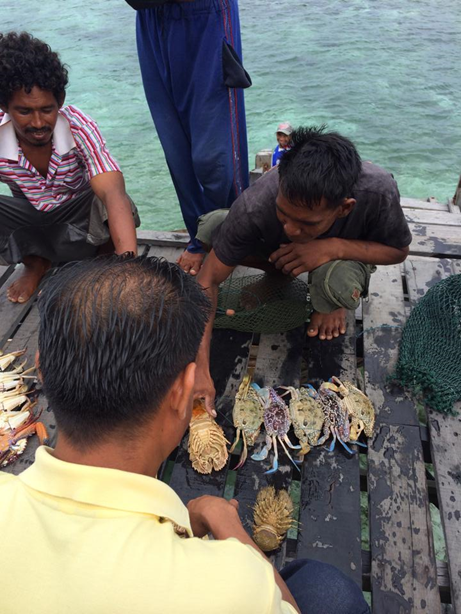
Figure 1: Pela’u fishermen selling their catch to tourist, Mabul Island, Semporna Sabah
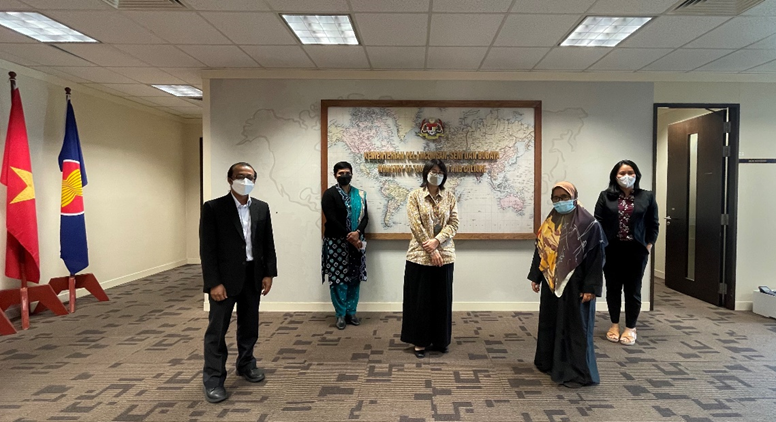
Figure 2: Courtesy visit to Ministry of Tourism, Arts and Culture Malaysia (MOTAC)

UNIVERSITI PUTRA MALAYSIA 43400 UPM SERDANG SELANGOR

Travel, Tourism & Hospitality

Tourism in Malaysia - statistics & facts
Slow but steady recovery, visit malaysia 2026, key insights.
Detailed statistics
GDP direct contribution from tourism Malaysia 2013-2022
Tourism receipts value Malaysia 2014-2023
Tourist arrivals to Malaysia 2014-2023
Editor’s Picks Current statistics on this topic
Current statistics on this topic, related topics, recommended.
- Accommodation in Malaysia
- Food industry in Malaysia
- Demographics of Malaysia
Recommended statistics
- Basic Statistic Value of international tourism spending APAC 2022, by country
- Premium Statistic GDP direct contribution from tourism Malaysia 2013-2022
- Premium Statistic Tourism industry direct contribution as share of GDP Malaysia 2013-2022
- Premium Statistic Tourist arrival growth in Malaysia 2013-2022
Value of international tourism spending APAC 2022, by country
Value of international tourism expenditure in the Asia-Pacific region in 2022, by country or territory (in billion U.S. dollars)
Gross domestic product direct contribution from tourism in Malaysia from 2013 to 2022 (in billion Malaysian ringgit)
Tourism industry direct contribution as share of GDP Malaysia 2013-2022
Direct contribution of the tourism industry as a share of the gross domestic product (GDP) in Malaysia from 2013 to 2022
Tourist arrival growth in Malaysia 2013-2022
Year on year growth of tourist arrivals to Malaysia from 2013 to 2022
Inbound tourism
- Premium Statistic Tourist arrivals to Malaysia 2014-2023
- Premium Statistic Number of tourist arrivals in Malaysia 2022, by country of residence
- Premium Statistic Inbound tourism expenditure of visitors in Malaysia 2015 to 2022
- Premium Statistic Inbound tourism expenditure of visitors in Malaysia 2022, by product
Tourist arrivals to Malaysia from 2014 to 2023 (in millions)
Number of tourist arrivals in Malaysia 2022, by country of residence
Number of tourist arrivals in Malaysia in 2022, by country of residence (in 1,000s)
Inbound tourism expenditure of visitors in Malaysia 2015 to 2022
Inbound tourism expenditure of visitors in Malaysia from 2015 to 2022 (in billion Malaysian ringgit)
Inbound tourism expenditure of visitors in Malaysia 2022, by product
Inbound tourism expenditure of visitors in Malaysia in 2022, by product (in billion Malaysian ringgit)
Domestic tourism
- Premium Statistic Number of domestic visitors in Malaysia 2013-2022
- Premium Statistic Number of domestic tourism trips in Malaysia 2013-2022
- Premium Statistic Average length of stay on domestic tourism trips Malaysia 2013-2022
- Premium Statistic Domestic tourism expenditure in Malaysia 2013-2022
- Premium Statistic Average expenditure on domestic tourism trips Malaysia 2013-2022
- Premium Statistic Domestic tourism expenditure of visitors in Malaysia 2022, by product
Number of domestic visitors in Malaysia 2013-2022
Number of domestic visitors in Malaysia from 2013 to 2022 (in millions)
Number of domestic tourism trips in Malaysia 2013-2022
Number of domestic tourism trips in Malaysia from 2013 to 2022 (in million)
Average length of stay on domestic tourism trips Malaysia 2013-2022
Average length of stay on domestic tourism trips in Malaysia from 2013 to 2022 (in days)
Domestic tourism expenditure in Malaysia 2013-2022
Domestic tourism expenditure in Malaysia from 2013 to 2022 (in billion Malaysian ringgit)
Average expenditure on domestic tourism trips Malaysia 2013-2022
Average expenditure on domestic tourism trips in Malaysia from 2013 to 2022 (in Malaysian ringgit)
Domestic tourism expenditure of visitors in Malaysia 2022, by product
Domestic tourism expenditure of visitors in Malaysia in 2022, by product (in billion Malaysian ringgit)
Hotel industry
- Premium Statistic Value added by the accommodation services industry in Malaysia 2017-2021
- Premium Statistic Number of hotels in Malaysia 2013-2022
- Premium Statistic Number of hotel rooms available Malaysia 2022, by state
- Premium Statistic Average occupancy rates of hotels in Kuala Lumpur, Malaysia 2013-2022
- Premium Statistic Number of foreign hotel guests in Kuala Lumpur, Malaysia 2013-2022
Value added by the accommodation services industry in Malaysia 2017-2021
Value added by the accommodation services industry in Malaysia from 2017 to 2021 (in billion Malaysian ringgit)
Number of hotels in Malaysia 2013-2022
Number of hotels in Malaysia from 2013 to 2022
Number of hotel rooms available Malaysia 2022, by state
Number of hotel rooms available in Malaysia in 2022, by state (in 1000s)
Average occupancy rates of hotels in Kuala Lumpur, Malaysia 2013-2022
Average occupancy rates of hotels in Kuala Lumpur, Malaysia from 2013 to 2022
Number of foreign hotel guests in Kuala Lumpur, Malaysia 2013-2022
Number of foreign hotel guests in Kuala Lumpur, Malaysia from 2013 to 2022 (in millions)
Economic impact
- Premium Statistic Gross value added tourism industries (GVATI) Malaysia 2013-2022
- Premium Statistic Share of GVATI in Malaysia 2022, by sector
- Premium Statistic Number of employees in tourism industry Malaysia 2013-2022
- Premium Statistic Tourism receipts value Malaysia 2014-2023
- Premium Statistic Breakdown of tourist expenditure Malaysia 2021
Gross value added tourism industries (GVATI) Malaysia 2013-2022
Gross value added tourism industries (GVATI) in Malaysia from 2013 to 2022 (in billion Malaysian ringgit)
Share of GVATI in Malaysia 2022, by sector
Share of gross value added of tourism industries (GVATI) in Malaysia in 2022, by sector
Number of employees in tourism industry Malaysia 2013-2022
Number of people employed in the tourism industry in Malaysia from 2013 to 2022 (in millions)
Total value of tourism receipts in Malaysia from 2014 to 2023 (in billion Malaysian ringgit)
Breakdown of tourist expenditure Malaysia 2021
Breakdown of tourist expenditure in Malaysia in 2021
Consumer behavior
- Premium Statistic Common issues about traveling among Malaysians 2023
- Premium Statistic Perceived level of safety when traveling with COVID-19 among Malaysians 2023
- Premium Statistic Main reasons for domestic travels Malaysia 2022
Common issues about traveling among Malaysians 2023
Most common concerns about traveling among tourists in Malaysia as of January 2023
Perceived level of safety when traveling with COVID-19 among Malaysians 2023
Perceived level of safety when traveling during COVID-19 among tourists in Malaysia as of January 2023
Main reasons for domestic travels Malaysia 2022
Main reasons for undertaking domestic trips in Malaysia in 2022
Further reports Get the best reports to understand your industry
Get the best reports to understand your industry.
- Tourism and hotel industry in Singapore
- Travel and tourism in Indonesia
- Tourism industry in Thailand
Mon - Fri, 9am - 6pm (EST)
Mon - Fri, 9am - 5pm (SGT)
Mon - Fri, 10:00am - 6:00pm (JST)
Mon - Fri, 9:30am - 5pm (GMT)
- Asia-Europe Institute (AEI)
- [email protected]
- +603 7967 4645

Malaysia's Tourism Industry Challenges Amid The Covid-19 Pandemic

AEI-Insights: An International Journal of Asia-Europe Relations ISSN: 2289-800X, Vol. 9, Issue 1, July 2023 DOI: https://doi.org/10.37353/aei-insights.vol9.issue1.5
MALAYSIA’S TOURISM INDUSTRY CHALLENGES AMID THE COVID-19 PANDEMIC
Gareth Liu Zi Yuan
Department of Southeast Asian Studies, Faculty of Arts and Social Sciences, Universiti Malaya, Kuala Lumpur, Malaysia
Although 2020 was supposed to be another “Visit Malaysia Year” and the Malaysian government had fully prepared for it; the Covid-19 pandemic put all the nation’s hopes on hold. The understanding of how the tourism industry in Malaysia can recover from a crisis is not yet complete, which has resulted in a lack of guidance for both industry professionals and researchers. The aim of this study is to determine the current state of Malaysia's tourism industry, evaluate the challenges faced by the industry, and provide recommendations to facilitate its recovery. Adopting a systematic review method, the study examined the difficulties faced by the Malaysian tourism industry, the challenges in different sectors, and the government policies recorded in 40 identified reports. A framework of recommendation that synthesises relevant research and targets to cushion the industry’s recession was established in order to enlighten future research in a Covid-19 or post-Covid-19 society on Malaysia’s tourism industry.
Keywords: Covid-19; Tourism Industry; Malaysia; 2020 Pandemic; Malaysia Tourism
Introduction
In the past 25 years, globalisation has become a buzzword (Bloom, 2020). More convenient moving and travelling, the rapidly developing internet, trade agreements, and fast-growing emerging economies all add up to globalisation’s explosion to an unprecedented height in recent decades and create a system in which people are connected to each other closer than ever. Due to this, the rapid global spread of Covid-19 has acutely impacted the global economy. People from all walks of life have been considerably affected, and the tourism industry is one of the worst hits by Covid-19. Most regions have been severely affected, which triggered a series of uncertainty, restrictions, and announcements made to undermine the tourism industry further which suggested that tourism-reliant destinations may not rebound from this pandemic (Wood, 2020). As a country that has been a popular tourist destination in the world for decades, during the pandemic, Malaysia has unfortunately experienced significant challenges.
Since the late 1990s, the tourism industry in the Southeast Asian region has been subjected to several crises accompanied by substantial falls in inbound tourism (Zahed, Ahmad & Henderson, 2012). Tourism in Malaysia emerged as vulnerable to regional and global events which act as a trigger for tourism crises, demanding a response in which various strategies are employed (Zahed, Ahmad & Henderson, 2012). Also, it is clearly difficult to anticipate and manage many tourism crises, considering the complex and multi-faceted nature of the industry (Faulkner, 2001; Prideaux, Laws, & Faulkner, 2003). Consequently, the tourism industry in Malaysia also faced multiple challenges and difficulties amid the pandemic.
The Covid-19 pandemic has been one of the most severe crises to hit the tourism industry globally, including in Malaysia. Malaysia, as a popular tourist destination, has been drastically impacted by the pandemic, with a significant drop in tourist arrivals and revenue. Malaysia's international borders were closed to most tourists in March 2020, resulting in a sharp decline in visitor arrivals and causing a ripple effect throughout the tourism industry, from hotels and restaurants to tour operators and transport providers. The pandemic's impact on Malaysia's tourism industry has been compounded by the government's strict measures to contain the spread of the virus, including lockdowns and movement restrictions. While these measures have been necessary to curb the spread of the virus, they have also had a severe economic impact, including on the tourism industry, which relies heavily on international visitors.
The implementation of the Movement Control Order (MCO) directly affected the local tourism industry’s deployment. The most affected one is the long-term prepared “Visit Malaysia Year (VMY) 2020. However, due to the raging Covid-19, the Ministry of Tourism Malaysia could only decide to cancel VMY 2020 in pity. The tourism industry is the second largest foreign currency income generator for the local economy. As the Ministry of Tourism’s original estimation, with the success of VMY 2020, the tourism industry could have brought the Malaysian government an expected income of RM100 billion. Yet, that hope is long gone. Covid-19 had forced the government to freeze the industry. For instance, out of countless tourist attractions, Genting Highlands is one of the most representative spots in Malaysia. In complying with the MCO, a total closure of the mountain’s casino, shopping malls, and entertainment venues was enforced. This is historically the first time that Genting Highlands has been closed for more than half a month since its grand opening five decades ago. Also, the multi-billion-ringgit outdoor theme park in Genting Highlands that was scheduled for a soft opening in the third quarter of 2020 has been postponed again. It was then estimated to open in the first half of 2022. To a great extent, this could illustrate how Covid-19 has cracked down on Malaysia’s tourism industry. Throughout the MCO period, most of the tourist attractions in Malaysia remained closed like Genting Highlands.
Following the closure of tourist attractions, a series of tourism-related events were also acutely affected by indefinitely postponed or directly cancelled. For example, the “George Town Festival”, scheduled to be held in July 2020 and 2021, is Malaysia’s annual international cultural event in Penang. The "George Town Festival" and the anniversary celebration of George Town's inclusion in the World Cultural Heritage were expected to attract a significant number of tourists and promote the local tourism industry's development as every year they invited artists from worldwide to perform. Inaugurated in 2010, GTW has been successful in positioning Penang as a cultural and arts hub, drawing attention to its rich heritage, unique attractions, and vibrant arts scene. These events typically draw in thousands of audiences and tourists from around the globe, which in turn generates revenue for the local economy and creates job opportunities. By cancelling these events due to Covid-19, the Malaysian tourism industry missed on an opportunity to showcase its cultural heritage, attract tourists, and boost the local economy.
The International Conference on Bajau/Sama and Maritime Affairs (ICONBAJAU 2020) and the Regatta Lepa and International Igal Festival 2020 were expected to contribute significantly to the promotion of sustainable tourism and the preservation of local knowledge. The conference, organized by the Sabah Native Affairs Council in collaboration with the Ministry of Tourism, Arts and Culture Malaysia (MOTAC), Universiti Malaya, Universiti Malaysia Sabah, and Sabah Museum, aimed to strengthen sustainable development goals through the exchange of knowledge and expertise. The conference would have addressed critical issues related to tourism, among other topics, and facilitated the exchange of ideas, knowledge, and practices. Similarly, the Regatta Lepa and International Igal Festival 2020, which is an annual event that celebrates the cultural heritage of the Bajau people, would have attracted thousands of tourists, and provided opportunities for the promotion of the state's tourism industry. The cancellation of these events due to the pandemic has resulted in short-term losses for the tourism industry and future strategy deployment of the state. It has also hindered the promotion of sustainable tourism practices and the preservation of the Bajau/Sama culture and heritage.
In conclusion, the Covid-19 pandemic has had a severe impact on Malaysia's tourism industry, which has faced numerous crises in the past. The complexity and multi-faceted nature of the industry make it challenging to anticipate and manage crises effectively. As a result, Malaysia's tourism industry is still struggling to recover from the pandemic's impact, highlighting the need for effective crisis management strategies and long-term planning to make the industry more resilient in the face of future crises. In order to have better preparation, two major research gaps must be identified and filled. Foremost, limited research is done on the long-term impacts of the Covid-19 pandemic on the tourism industry in Malaysia, such as changes in consumer behaviour and preferences, and the sustainability of the industry in the post-pandemic period. Simultaneously, there is a lack of comprehensive studies on the effectiveness of the government's policies and strategies to support the tourism industry during the pandemic, including the allocation of funds and resources, and the implementation of various initiatives.
This study could have significant practical and policy implications for the government, tourism industry stakeholders, and the general public. Firstly, the study could provide insights into the current state of the tourism industry in Malaysia during the pandemic, including the impact of Covid-19 on tourism demand, supply, and employment. This information could be used by policymakers to formulate effective measures to support the industry and mitigate the negative effects of the pandemic. Additionally, the study could identify the key challenges facing the tourism industry in Malaysia and propose strategies to overcome them. This could include recommendations on how to diversify tourism offerings, develop new marketing and promotion strategies, and improve infrastructure and services to enhance the overall tourism experience. Last but not least, the study could contribute to the academic literature on the impact of the pandemic on the tourism industry, particularly in the context of Malaysia. This could help to advance the understanding of how pandemics affect the tourism industry and provide insights into how to better prepare for future crises.
Literature review
Tourism is considered one of the key resources in the development of modern societies (Freitag & Buhlmann, 2009). It promotes economic development and improves societal well-being (Herreros & Criado, 2008). Tourism activity has grown tremendously all over the world throughout the past twenty years (Hamzah, 2004), and it has become multiple countries' pillar industry that contributes to economic development. Since 2000, international tourism has grown significantly. In 2019, international tourist arrivals reached a total of 1.5 billion in 2019, representing a 4% increase from the previous year (UNWTO, 2020). The growth of the tourism industry is crucial to economic growth and related fields such as transportation, leisure services, and hospitality (Telfer, 2002). The tourism industry's impact on other industries has both positive and negative effects. According to the World Travel and Tourism Council (WTTC), tourism accounts for 10% of the world's GDP and jobs (WTTC, 2021). The Covid-19 pandemic has significantly impacted the tourism industry, with up to 50 million global travel and tourism jobs at risk, and a 25% decline in travel in 2020 (WTTC, 2021). The Asia-Pacific region is expected to be the most affected, with WTTC analysis and statistics projecting that approximately 30 million of the 50 million jobs at risk could be in Asia (Faus, 2020).
The main ‘essence’ of tourism experience remains something similar, namely feeling happier, better rest, closer to the family, less stress, and more relaxed (Euromonitor 2015). As an upper middle-income country, Malaysia's national tourism has entered the era of leisure-and-vacation-oriented tourism. The demand from tourists is more diversified compared to the past; also, the demand from the spiritual and cultural aspects is stronger than before. Cultural tourism products are drawing significant attention as interest in experiencing and learning about different cultures has grown widespread among tourists today. The assumption is that if tourism policymakers are not clearly defining their cultural values, along with appropriate strategies to restore their authenticity, it is likely that most of the cultural uniqueness will be underutilised and eventually lost (Debes, 2010). This principle can be used for Malaysia’s domestic inbound, outbound as well as international inbound tourism development.
Nevertheless, the tourism market is still mainly filled with sightseeing-oriented products. The little presence of culture-oriented products shows the imbalance of tourism product structure and the obvious mismatch between market supply and demand. At the same time, now in Malaysia, investment in the tourism industry prevails, the governments hope to earn more income out of the tourism industry by developing and promoting new scenic spots. However, there is a lack of creativity in both the development and promotion strategy of tourism projects. In a news article published by The Star in 2019, Malaysia's Tourism, Arts and Culture Minister at the time, Datuk Mohamaddin Ketapi, acknowledged the need for new and creative approaches in the tourism industry. The article also mentioned the importance of diversifying tourism products and services to cater to the changing demands of tourists. Apart from that, the homogenisation of scenic spots can be commonly seen, which finally leads to overheating or inefficient tourism investment. For instance, the mural painting which goes popular nationwide overnight. A system or management needs to be developed that takes every issue and challenge into consideration so that the decision-making process is reliable to optimise the value of assets in the Malaysia tourism industry (Ismail, Masron & Ahmad, 2014).
Tourism has been an important industry in Malaysia for a number of years (Khalifah & Tahir, 1997; Musa, 2000), and Malaysia has been one of the top two most popular tourist destinations in Southeast Asia and the Pacific regions (UNWTO, 2011). Before the pandemic, “Malaysia received around 26 million international tourists along with RM86.1 billion contributions to the revenue. The tourism industry has brought RM240.2 billion income to the country as one of the pillar industries, which consists of 15.9% of the national GDP” (Ministry of Tourism, Arts and Culture Malaysia, 2019). Even though there have been many scholars and studies drawing attention to crisis management in tourism; rather few of them have specialised in the aspect of the tourism industry’s countermeasures for the public health emergency, especially in the context of Malaysia. Goodall and Ashworth (2013) noted that the growth of the global tourism industry has prompted governments to recognize the economic and social benefits it can bring. However, the success of tourism depends on destination regions effectively marketing the destinations and managing crises.
According to Kadir, Ahmad, and Johari (2019), the intense competition in Southeast Asia requires Tourism Malaysia to develop effective strategies and attractive promotional packages to attract visitors. Four main challenges and pitfalls in the Malaysian tourism industry are the reduction of tourist arrivals, the need for skilled labour, the adoption of technology, and catering to the needs of Muslim travellers. However, one challenge that was not anticipated is the unexpected public emergency such as the Covid-19 pandemic, which has resulted in a significant decrease in tourist arrivals. Perimbanayagam (2020) revealed that tourist arrivals and spending were reduced by more than half in the first half of 2020 due to the Covid-19 pandemic. In 2020, the numbers dropped by 68.2 and 69.8 percent, respectively, from the same period the previous year, as claimed by Tourism, Arts, and Culture Minister Datuk Seri Nancy Shukri. Therefore, the concept of resilience has become vital in the tourism industry as pointed out by Chowdhury and Chhikara (2020).
However, the resilience of the local tourism sector alone is not enough to sustain. The Malaysian government and the public should also play a role in providing support. Hamid, Hashim, Shukur, and Marmaya (2020) stated that Malaysia is banking on its domestic tourism industry to provide momentum for tourism sector recovery and support. The government's measures to enhance resilience in the Malaysian tourism industry during the pandemic need to be further researched. Therefore, understanding the status of Malaysian tourism during the pandemic can help reinforce the industry's resilience in the future. The Covid-19 pandemic's response can catalyse the reinvention of the tourism industry's supply chain, and this study can serve as the basis for a more responsive and flexible operation. This study aims to fulfil the aspiration of summarizing the short-term elements of struggle while providing a foundation for a more resilient tourism industry in the future.
Methodology
The study focuses on the difficulties and challenges caused by Covid-19 for Malaysia’s tourism industry, based on the researcher’s six-month-long data collection and information accumulation from considerable channels of the sector. The researcher mindfully studied and referred to dozens of facts and findings from journal papers, publications, and authorised presses mostly between 2020 and 2021 in various aspects of the condition of the Malaysian tourism industry. A systematic review of these relevant literature was performed accordingly, which particularly assessed the Malaysian tourism industry during the Covid-19 crisis. The Systematic Literature Review (SLR) is a suitable method for this study because it synthesizes findings from recent journal papers, publications, authorised presses, and reports while narrowing the information gap, thereby offering suggestions and directions for further research. In this study, a three-step system for identifying literature was set up: screening and evaluating the relevant literature in order to answer the research questions. Consequently, the study is primarily made up of the SLR, and partially the secondary monographs which were creditably published by other researchers, as well as 10 detailed semi-structured interviews and discussions with the practitioners.
Search Strategy
The beginning of the three-step process starts with a thorough literature search. The researcher ranges literature published from 1 January 2001 to 31 December 2021. The starting date of 1 January 2001 was chosen because it marks the beginning of the 21st century and the era of globalisation, during which the tourism industry underwent significant changes and growth. This period saw the emergence of new technologies, increased international travel, and the development of new tourism markets, among other factors. The Covid-19 pandemic, which has had a profound impact on the tourism industry, began in 2019 and reached its peak in 2020. By including literature published from 2001 to 2021, the researcher is able to examine the tourism industry's trajectory over a 20-year period, including its response to previous crises and the impact of the pandemic. The year 2020 is the most significant as it is the year that the Covid-19 pandemic emerged.
The ISI Web of Science (WoS) was employed as the scientific search engine to look for matching literature. Despite the fact that WoS is considered the most widely utilised search engine for literature reviews; it does not include adequate tourism journals and updated news reports. The comprehensive internet search engine was therefore applied as the complementary database because its coverage is wider. The search profile was according to multiple primary search terms, the terms chosen were based on a literature review on the Malaysian tourism industry and crisis. In both WoS and online search engines, the “hospitality, tourism, leisure, and sports” category was used to modify and narrow down the hunt for suitable literature and information.
Inclusion Criteria
In terms of the main article selection, the inclusion criteria for this study were: 1) employment of the keywords designated for the title and abstracts of articles, 2) completed research, 3) research conducted concerning Malaysia, 4) English language literature, 5) use of quantitative and qualitative research methods. The exclusion criteria included: 1) abstracts only, 2) studies published in other languages that were unfamiliar to the researcher. Duplication was excluded too. Studies which fulfilled the inclusion criteria were listed and compared. When it came to the news and information selection, the inclusion criteria for this study were: 1) use of the keywords designated for the title and abstracts of articles, 2) confirmed sources, 3) solely associated with the subject of Malaysia, 4) English, Chinese or Malay language as a medium, 5) credible platform with evidence in publishing. The exclusion criteria included: 1) unverified information or unofficial sources, 2) reports released in other languages that were unfamiliar to the researcher, 3) repeated or redundant content of information. News reports that met the inclusion criteria were coded and authenticated.
Study Limitations
The study's limited time frame, which only covers the literature published from 1 January 2001 to 31 December 2021, and the exclusion of certain reference resources, including reviews, field surveys, observational studies, case studies, and news reports, are potential methodological limitations of the review. However, these exclusions were necessary to ensure the review's focus and reliability by prioritizing academic literature that met specific inclusion criteria, such as peer-reviewed articles and empirical studies. These sources were selected because they are more likely to provide rigorous and reliable information and analysis, which is essential for producing a credible review. While the exclusion of other reference resources may limit the review's scope, the approach adopted by the researcher enables a more in-depth and critical analysis of the academic literature relevant to the study's research questions.
Figure 1 displayed the procedure followed for the purposes of this review and outlined the characteristics of the chosen references. Foremost, 120 studies/papers and other references such as books, conference proceedings, reports from the aforementioned databases were identified. Out of the 120, 44 were rejected after reading the shortlisted data as they were either duplicates or they had no proper abstract or were not composed in the researcher’s familiar language. Amongst the remaining 76 references, nearly half of them is Malaysia tourism-focused literature (n=36, 47%); original research articles (n=21, 28%); and non-research articles that consisted of reviews, case studies and news reports (n=19, 25%). Many of the literature references reported concrete evidence obtained on all sectors of the tourism industry including the overall industry (tourism) (n=27, 35%), hotel and F&B only (n=5, 7%), tourism agency only (n=3, 4%), aviation only (n=3, 4%), tourist attractions only (n=3, 4%), policy only (n=16, 21%), crisis management (n=19, 25%). 26 papers out of the literature references were written before 2011, nine out of the literature references were written from 2012 to 2019, and 50 out of the references were written after 2019, which indicates the severe impacts that the pandemic has brought to the tourism industry of Malaysia and the attention that the crisis management of tourism is drawing.

Difficulties and Challenges of Tourism during Covid-19
Tourism in Malaysia has been regularly and negatively affected by a series of crises that have struck the industry in the past two decades. The major ones include the 2004 Indian Ocean tsunami and the 2003 SARS epidemic and the subsequent outbreaks of H1N1 (Zahed, Ahmad & Henderson, 2012). Since March 2020, Malaysia’s Covid-19 prevention and control have pushed tourism to a passive status. For the sake of guaranteeing the well-being of the nationals and effectively fighting against the pandemic, the government implemented a series of "Movement Control Order" (MCO). Under the devastating influence of Covid-19, carrying out MCO had put local tourism and its related industries in a position that is more difficult than ever. The attack of Covid-19 is a disastrous blow to all tourism industry practitioners in Malaysia, where the pressure and challenges that the industry has to face are unprecedented. The MCO, effective from March 16, which was supposed to last for two weeks only due to the unstable situation, was extended all the way to 2022. Throughout the MCO period, foreigners were prohibited from entering Malaysia (except for work purposes or the spouse of a Malaysian), and nationals without valid reasons were prohibited from going abroad, crossing states, and attending gatherings 1 . All sightseeing activities were cancelled or restricted, as everyone’s daily movement must follow standard operating procedure (SOP).
The tourism industry-related service line was also brutally decimated as part of the chain reaction. During the last decade, Malaysia consistently did well in attracting tourists from more countries and regions. Therefore, local hotels flourished. But in 2020 and 2021, due to the enforcement of MCO together with the entry ban, many hotels struggled to survive. Mr. Yap Lip Seng, the CEO of the Malaysian Hotel Association revealed that Malaysia will lose at least 60% of its tourism business by 2020. Within the industry, wages will be cut, and unpaid holidays will be practised as this is the only chance to save jobs. However, often, smaller hotels cannot afford this. Eventually, thousands of practitioners in the industry will find themselves ending up closing their business. To support the tourism businesses, the government and practitioners decide to use some hotels as mandatory quarantine centres to provide accommodation for Malaysians returning from overseas. Although the government promised RM150 per room per night and more than 23,000 rooms and 190 hotels appeared on the list; still, many of them were nevertheless not fully occupied. Senior Minister Ismail Sabri Yaakob said the authority welcomes volunteers, and the volunteering hotels would be given Sales and Services Tax exemption for their involvement. Hotels willing to help could get in touch with the National Disaster Management Agency (Nadma) and the Tourism Ministry. The Malaysian Hotel Association, therefore, assumed that the emergency scheme would not lead to a significant upswing, but it still helped the participating hotels, considering that there was almost no income at all during this period. To a certain extent, this created a win-win situation for some hotels to weather the storm at that moment. According to the statistic given by the minister of tourism Datuk Seri Nancy Shukri, from March to October 2020, in total there were 109 hotels and guesthouses that shut down nationwide.
It was also a challenging period for the aviation industry. Air travel, being a dependent commodity, sees its demand affected by a variety of factors (Rhoades & Reynolds, 2007). Malaysia’s tourist travel was primarily relying on international and domestic flights. According to what the Malaysian Aviation Commission revealed, due to the Covid-19 pandemic, up to 1576 flights between January 1st and February 29th, this year were cancelled, which includes 376 Malaysia Airlines flights, 644 AirAsia flights, and 114 long-distance AirAsia X flights, and 442 Malindo flights. Starting from March 2020, with the imposition of MCO, the tourism industry in Malaysia experienced a significant decline. This led the Malaysian government to take steps to address the crisis by announcing the merger of the national airline, Malaysia Airlines, with the low-cost airline, AirAsia. The objective of this merger was to save both airlines and help them to navigate the ongoing Covid-19 pandemic. However, the pandemic continued to impact the aviation industry, resulting in significant losses for Malaysia's two largest airlines. On the one hand, the domestic traffic by flights among states diminished; on the other hand, there were nearly no international flights. By the end of 2020, Malaysia Airport lost 75.5% of tourist arrivals compared to 2019. The whole aviation industry looked at a lag of 3 years at least before the businesses could bounce back to pre-Covid-19 days.
There was extremely low demand from the market as there were no more tourists. Thus, on account of the freezing of the industry, all the practitioners were soon getting unemployed. In Malaysia, there were over 3.6 million nationals in the tourism industry, which counts for 23.6% of the entire workforce. Referring to the Kenanga Investment’s research results, with the interference of MCO and supply chain, Malaysia’s unemployment rate soared to its highest level in 10 years in March 2020. The unemployment rate reached a high of 4 to 5%. Economists believed that the unemployment rate was expected to rise in the future, and tourism-related fields may be the hardest-hit industry. Following an analysis by the Affin Hwang Capital, employment in the tourism industry alongside its related fields affected by Covid-19 had potential downside risks and may drag on the overall employment performance. It was estimated that the annual unemployment rate of the tourism industry may rise to 5-6%, which was much higher than the 3.3% in 2019.
The recession is real. From March to December 2020, Malaysia's tourism industry entered the “off-season” period. The hibernation market and bleak financial condition have made all the practitioners now suffer and have started to look for self-help. According to the interview with the practitioner, the average loss for the small-size tourism agency was about RM15,000 per month. In terms of large travel agencies, most required employees to take unpaid leave. Some were laid off. Since February 2020, most of the bookings were cancelled. During the Recovery Movement Control Order (RMCO) period, the situation was slightly eased. As the third wave of pandemic started again in October 2020, the local tourism agencies had no business to run again. During such hardship, compared to the inbound group-oriented tourist agencies, those who ran more outbound groups were at a greater risk. According to the interview with the practitioners, during the pandemic the public was restricted to visit offshore destinations and the fear of visiting most countries, tourists would first request a withdrawal. However, usually, the airline and hotels will not allow the travel agency to withdraw the group tickets easily. The airline will follow its rules to detain the funds or postpone the bookings for three months, so the travel agency found difficulty in maintaining its cash flow. In order to keep surviving, many of the practitioners in the tourism industry took up part-time jobs or transferred to other industries. With the cancellation of tour groups, local tour guides faced the dilemma of unemployment. A large number of local tour guides received no job all year long. Before the implementation of MCO, the local tour guides launched some hidden spots in remote suburbs to try to save the stark local tourism industry. However, after the MCO, the tourism industry was completely suspended. Among all types of tour guides affected, those using Chinese as the medium of communication were the most affected. In the past several years, owing to the spike in numbers, the Chinese tour groups dominated the market. The demand for Chinese-speaking tour guides was the highest. Amid the pandemic, as Chinese tour groups have stopped coming to Malaysia, nearly all Chinese-speaking tour guide jobs have been paused.
Government efforts to overcome the difficulties and challenges
Concerning the great depression of the tourism industry in Malaysia, the federal government and the state government have both put forward plans to help the tourism industry and its practitioners. At the federal government level, the government has devised multiple measures to minimise the short-term impact of the pandemic, aimed primarily at the tourism industry. In the “Prihatin Rakyat Economic Stimulus Package”, the government guarantees the affected tourism industry’s practitioners income tax instalments which were suspended for six months. Before this stimulus package, the government allocated RM500 million to provide a 15% discount on electricity bills for the tourism sector. After MCO began, the Malaysian government demanded financial institutions to provide financial relief to borrowers by rescheduling or restructuring loans, and also offering payment moratoriums. There was a 100% stamp duty exemption arising from these rescheduling, restructuring, or moratoriums. The exemption was given until the end of 2020. The government can assist the cash flow of small and medium-sized enterprises (SME), as it had prepared a RM200 million and a RM500 million micro-credit scheme for small businesses in the tourism industry, and Bank Negara Malaysia was going to provide RM2 billion-worth in loans for SMEs. Each SME will be eligible to receive up to RM1 million with a tenure of 5.5 years. Moreover, Travel agencies, hotels, airlines, as well as businesses in the tourism industry, were given a deferment of their monthly tax instalments for six months starting April 1, 2020. Hotels were also exempted from service tax from March 1, 2020, until August 31, 2020.
To support the restoration of the tourism industry, the federal government allocated USD113 million in the form of travel discount vouchers and sharpened tourism promotion. The government collaborated with airlines, resorts, and hotels to offer discount vouchers of RM100 per person starting in March 2020. RM30 million was funded to Tourism Malaysia to increase the promotion of Malaysian tourism in the Middle East, Europe, ASEAN, and South Asia. In addition, a special income tax relief worth RM1,000 was available to individuals for expenses on domestic tourism from March 1 to August 31, 2020. It was limited to entrance fees for tourist attractions and expenses on accommodations at premises registered with the Ministry of Tourism, Arts, and Culture. While the effect of the policies and strategies being employed still needs to be further examined, the tendency and determination shown through actual movements to bring back the normalcy of domestic tourism have already released a positive signal and formed a solid start for the tourism industry to heal the wound. In November 2020, Tourism, Arts, and Culture Minister Datuk Seri Nancy Shukri said the government was upbeat about assisting tourism industry players in the country who had been badly affected by the Covid-19 pandemic for the survival of the industry. This was proven through the RM200 million allocation for the Tourism Recovery Plan under the Budget 2021, as tabled by Finance Minister Zafrul Aziz, and it was not a supplementary budget as it was the Budget for tourism for 2021. Apart from that, there was also an allocation for handicrafts. If in 2020 the ministry received only RM57 million, it would receive RM91 million for 2021. Under the Tourism Recovery Plan, "the Ministry would be implementing several initiatives such as discounts for tourist destinations, family holiday packages, arts and culture promotion, accommodation vouchers and Meet in Malaysia campaign," said the minister.
By the end of 2020, the government was showing its determination to rebrand Malaysia as among the 'Top of The Mind Ecotourism Destinations of the World' despite the local tourism industry struggling to survive amid the daunting pandemic. The goal to bestow Malaysia amongst the top ecotourism destination in the world would be possible with the implementation of the National Tourism Policy 2020 – 2030 (Dasar Pelancongan Negara 2020 - 2030) which was announced and launched by the Prime Minister Muhyiddin Yassin. Following the 17 objectives listed in the United Nations Sustainable Development Goals (UNSDG), Muhyiddin Yassin the then Prime Minister, said the DPN 2020-2030 was Malaysia's dynamic and strategic plan to spur the tourism industry in the country. According to National Tourism Policy 2020-2030 (MOTAC, 2020), other than sharpening Malaysia's competitiveness, Muhyiddin also mentioned that DPN 2020 – 2030 would be serving as a blueprint for Malaysia to build an inclusive and sustainable tourism industry that is well-prepared and resilient against potential disasters in the future. According to the Prime Minister, "the policy will be implemented through six core strategies namely governance transformation, establishing inclusive tourism investment zones, intensifying tourism digitalization, enriching the experience and satisfaction among tourists, strengthening commitment towards building sustainable tourism as well as increasing human resources capacity within all tourism sub-sectors". The government is aiming at luring more domestic and international investors by reviving cooperation between the public and private sectors through the Special Tourism Investment Zones. Also, technology-centred tourism development will be greatly encouraged as “technology development will strengthen the industry's network apart from paving the way for new innovative sub-sectors within the tourism sector and subsequently create more business and employment opportunities”. The PM believes that to “ensure the tourism product developments remain sustainable, competitive and inclusive as indicated under the DPN 2020-2030 is the government’s shared responsibility; hence, all parties are urged to work closely with the Tourism, Arts and Culture Ministry to confirm that the objectives outlined under the DPN 2020-2030 could be achieved”.
At the state level, in Pahang, Chief Minister Datuk Seri Wan Ismail announced the state government had set aside RM63,900 for tour guides whose livelihoods have been affected by the pandemic. 426 individuals comprising Taman Negara nature tour guides, and Taman Negara tour boat operators will each receive RM100 cash along with essential items worth RM50. Despite the initiatives appearing to aid, the processes involved in their implementation have been riddled with complaints. Referring to the chairman of Pahang Tourist Guides’ Association, Mr. Chin Yeong Chyuan, of the 130 active and registered guides of the association, only 7 received the allowance. At the end of March 2020, the State Tourism Administration - Tourism Pahang announced the second day after the state’s initiative is out, it has already assisted the Ministry of Finance with information about the qualified tour guides in the state. Later, the tour guides submitted personal information online. Most of the applicants who were eligible for the allowance, even though they have completed the online form and attached the bank account number through the official website of the Ministry of Finance; did not receive anything for two months. However, the Ministry of Tourism and the Ministry of Finance were unable to respond directly to this situation. Consequently, the initiative did not get to help the tour guides in the State promptly.
In the case of Johor, according to the report of New Strait Times, in May 21, 2020, the state government announced several incentives to assist the tourism industry players, including the allowance of one-time assistance to qualified tour guides, and exemption from the license fees of travel agencies and hotels, so as to help them survive the challenge. Johor State Tourism Committee chairman Datuk Onn Hafiz explained that 936 qualified tour guides living in Johor would receive the RM1,000 allowance, involving a total amount of RM936,000. The state government also exempted the license fees of travel agencies and hotels in the state in 2020. It is estimated that 1,031 license holders would benefit, and the exempted license fees were expected to reach RM 894,211. At the same time, theme parks and family entertainment centres in the state were waived from the entertainment duty that year too, which was about RM3 million. In addition to the above-mentioned benefits, the Johor State Tourism Committee worked on developing both long-term and short-term strategies to revive the tourism industry in the state after the end of the Covid-19 pandemic. The state government expected the incentives would help the industry practitioners to overcome the difficulties and challenges, and also to improve the performance of the tourism and service industry of the state.
As for Perak, based on the report of Sin Chew Daily, on December 24, 2020, Nolee Ashilin, who is in charge of the state’s housing and tourism, unveiled that the state would allocate 1.2 million to boost the tourism sector, which contained a one-time allowance for the native tour guide (RM 700 per person) and travel agency (RM 2000 per company), 10,000 #TravelPerakLah vouchers, and the one-time RM10,000 subsidy for 12 native tourism organisations and non-government organisations. According to her, the allowance for the registered tour guides and tour agencies was given to appreciate the practitioners’ effort to develop the tourism industry in Perak and to rejuvenate the sector during this pandemic. A subsidy for NGOs and tourism organisations was given to promote new tour packages to attract tourists to visit Perak. The continuously distributed travel voucher covered sightseeing, accommodation, and package, to maintain and enhance the confidence of tourists towards tourism in Perak. The state government allocated 4.4 million to support local tourism through the improvement of existing tour packages and marketing, with the aim of maintaining a dynamic and satisfactory tourism market that would encourage repeat visitation and consumption.
In line with UNWTO’s data, in the first 10 months of 2020, the number of international tourists’ arrival dropped by 72%, which is historically the lowest since 1990. The number of tourists travels internationally is 900 million less than in 2019, which roughly equals to a USD935 billion loss. Hence, the organisation called on countries to step up their response to the pandemic without panic. Countries should take appropriate measures according to their condition to cushion the negative impact on the tourism industry, while unnecessary panic and extreme policies will lead to worse consequences than the pandemic itself. Effective crisis management can enhance the resilience of tourism organisations and destinations in crisis situations, strengthen their defence mechanisms, limit potential damages, and allow them to bounce back to normalcy faster (Paraskevas, Altinay, McLean & Cooper, 2013).
The government must keep the information open and transparent so that the general public will know the latest situation in time. In this process, the mass media plays an important role. For example, back in 2004, after the deadly tsunami, the media exaggerated the extent and harmful outcomes of the crisis and neglected the post-crisis period, failing to help rebuild tourists’ confidence by circulating positive stories. This is a universal phenomenon and there were many instances where media coverage has exacerbated and perhaps prolonged a destination’s crisis (Beeton, 2006). The government needs to lead a more proactive role in regulating, assisting, and reviving the tourism sector to heal. The tourism industry has been systematically impacted by the negative effects of the Covid-19 pandemic. On the one hand, the most direct impact of the pandemic on the supply side is that tourism-related enterprises suffer heavy losses and were trapped in a survival crisis, especially for small and medium-sized enterprises. On the other hand, the present suspension has provided a buffer period for the authority and practitioners to reflect and try to solve the problems that popped up in the industry.
Based on the literature reviewed, the findings on the challenges and issues faced by the tourism industry in Malaysia amid the Covid-19 pandemic are mostly in line with previous research. The reduction of tourist arrivals, supply-demand mismatch, underemphasis on domestic tourism, and lack of resilience have been identified as major challenges in the Malaysian tourism industry in previous studies. In addition, the impact of unexpected public emergencies such as the Covid-19 pandemic on the tourism industry has also been discussed in previous research, but not so much in the case of Malaysia. This discussion, thus, highlights the importance of domestic tourism development and soft power enhancement in the Malaysian tourism industry. Previous research has also emphasised the importance of domestic tourism in sustaining the tourism industry during times of crisis, and the potential of soft power to attract visitors to a destination. These are consistent with prior literature on the challenges and potential solutions for the tourism industry in Malaysia. However, it is important to note that the tourism industry is constantly evolving, and new challenges may emerge in the future. Therefore, ongoing research and analysis are necessary to ensure the sustainability and growth of the industry, especially when the pandemic is still underway.
The supply-demand reform for tourism products and industrial structure
In this Covid-19 crisis, not only effective tourism supply is facing a survival crisis, but also the ineffective supply is more likely to be eliminated. According to the official website of Malaysia Tourism Promotion Board , various types of high-quality tourism resources in Malaysia are listed, including natural attractions such as national parks, beaches, islands, and rainforests; cultural and heritage sites such as temples, mosques, museums, and historical buildings; and adventure and sports activities such as diving, trekking, and water sports. After the recovery of the tourism market, and to precisely meet the manifold modern tourism demand, those high-quality local tourism resources that have been put aside in the Covid-19 crisis should be revitalised and optimised through the creative packaging and cultural implantation, to further increase the supply-side structural reform of the tourism industry. Moreover, an effective reorganisation and integration of tourism assets in the post-Covid-19 era could possibly change the competitive pattern of the tourism industry. Demand-wise, under the Covid-19 pandemic, there are hardly any tourists travelling between countries. The whole world is facing the same dilemma. Thus, in order to warm up and let the industry recover, the industry also needs to adjust and upgrade on the demand side, where demands must be stimulated and guaranteed again. For the sake of boosting the local tourism industry, the authority and the nationals of Malaysia have to play the most significant roles.
With regards to the supply side, tourism enterprises, especially small and medium-sized enterprises, need to solve the survival problem. The government should take the initiative to mitigate the immediate impact of the Covid-19 crisis. Other than current financial measures, the government may utilise different tools to ease the practitioners’ burden. For example, rent subsidies can be provided for tourism sector-related offices, buildings, and event spaces. Also, reasonable extra allowance from the federal government can be offered to those with zero income to help fulfil their essential needs. In addition, although crises and disasters cannot be stopped, their impacts can be limited by both public and private sector managers (Ritchie, 2004). During the MCO period, practitioners should seize the suspension of tourism to conduct a comprehensive survey regarding the market rather than simply relying on promotion after Covid-19 to rebuild their businesses. It will be wise for the industry to reshape products and services according to market demand because when the pandemic is over, the pent-up tourism demand will possibly be released rapidly or even multiplied in a short time. At this stage, only when the online marketing and the plan for returning to work are made, can the tourism blowout in the post-Covid-19 era be welcomed. Last but not the least, Ritchie (2008) also notes that understanding and subsequent management of incidents can be vastly improved through the extension and application of crisis and disaster management theory and concepts from other disciplines, coupled with the development of specific tourism crisis management research and frameworks. The public health emergencies have alerted the tourism industry to establish a tourism emergency mechanism as soon as possible. It should range from the system, materials, personnel, funds, and all other aspects, to provide security and preparation for the local tourism industry to cope with any unexpected crisis.
In relation to the demand side, the government needs to prioritise the restoration of the domestic tourism market, which is the paramount strategy for the Malaysia tourism industry to recover. Hetherington (2004) remarks that political trust operates like a stimulus that influences citizens’ decisions to support or oppose government policies. He argues that support for an expansion of services is likely high if the public perceives the institutions that will deliver those services as trustworthy. Due to the consideration of public health and safety, the recovery of the inbound tourism market will be later than that of domestic tourism. Trust is important to understand the world, functioning of institutions, decision-making processes, and social, political, and community relations because it underlies human and social life (Stein & Harper, 2003). Therefore, when revitalising the inbound tourism market, the authorities and the industry should establish a “safe destination” image to show the international society and vigorously develop tourism insurance to rebuild the trust of inbound tourists to the country. Bramwell and Lane (2011) comment that because the government has a primary influence on governance and policymaking for sustainable tourism, the roles and activities of the states directly affect tourism and the sustainable development of the industry and destinations. Thus, the biggest challenge after Covid-19 for the government will be restoring the trust of domestic and foreign tourists. The "Clean and Safe Malaysia" campaign is one of how this is to be achieved. The aim is to award certification to hotels that meet the requirements of the relevant authorities. Also, airlines, hotels, transport companies, and other operators should consider collaborating to provide joint travel packages. This will reduce costs for businesses and visitors and make the country's tourist industry more competitive.
The prioritised domestic tourism restoration for nationals
In a social media post by the Malaysian Tourist Board back on 16 May 2020, they had encouraged nationals, under the hashtag “#TravelLater”, to explore their own country after the crisis to bolster the local economy. Datuk Musa Yusof, the then director-general of Tourism Malaysia, had projected that it could take months for the tourism industry to recover from the impacts of Covid-19 and emphasized that the industry would need all the help it could get to rebuild. Historically, the domestic tourism market is usually the first to recover in the post-crisis era. Indeed, the inbound market can typically only stabilize and revive once the domestic tourism market has recovered. Reflecting on these past strategies in 2023, it's evident that Malaysia's concerted efforts to curb the pandemic led to a substantial growth in the tourism industry as initially hoped. Public support for tourism development, as Nunkoo & Ramkissoon argued in 2011, remains a prerequisite for the sustainable growth of the industry. Any lack of such support can hinder the growth and future potential of a destination. Therefore, it's crucial for a destination's government to gain the community’s endorsement for tourism to ensure socially compatible development. During the peak of the pandemic, the sentiment "Must go jalan jalan" resonated with many nationals who had been strongly advised to stay at home for several months. This sentiment drove a quick recovery in industries related to open-air natural scenic spots, such as the National Park in Pahang, Langkawi Island in Kedah, and Mount Kinabalu in Sabah. In retrospect, the key focus for the government and the industry was how to transform outbound tourism into domestic tourism in order to restore the total domestic tourism to pre-pandemic levels.
According to an Oxford University researcher Per Block’s definition, “travel bubbles, do away with that waiting period for a select group of travellers from certain countries where the coronavirus has been contained. In a ‘travel bubble’, a set of countries agree to open their borders to each other but keep borders to all other countries closed. Hence, people can move freely within the bubble, but cannot enter from the outside”. Since the RMCO stage began, the government eyes to create and consolidate the “green travel bubble”. Compared to directly pushing the bubble to an international level, the federal government aspires to practise it among states to stimulate the domestic tourism market. Thus, the “green travel bubble” scheme was launched in November 2020 to resuscitate the local tourism industry. “Green travel bubble under the tourism recovery plan, has three main objectives - first is to restore the people’s confidence to travel again, second is to revive the domestic tourism industry, and finally to maximise the available resources. Vehicles travelling within the travel bubble cannot make any stop in or cross red zones without first obtaining permission from the police”, said the tourism minister Datuk Seri Nancy Shukri. To further revitalise and invigorate the tourism sector, the minister also revealed that MOTAC has prepared SOPs and is ready for the international green travel bubble. The bubble initiative originally envisioned allowing Singaporeans to first vacation in Langkawi, which had been declared a virus green zone. Once the pandemic was effectively controlled in Malaysia, the plan was to gradually expand this travel bubble to include Hong Kong, Macau, Australia, New Zealand, China, Taiwan, Vietnam, and Thailand. This progression was designed to slowly permit travel for business and medical tourism purposes, eventually culminating in leisure and sightseeing tours by April 2022. Given the current year, it's important to evaluate and acknowledge the outcomes and impact of these strategies.
The attractive soft power enhancement tool for quality foreign tourists
Nye (1990) came up with a definition for “soft power” as “the ability to get what you want through attraction rather than through coercion”. From the perspective of soft power enhancement, Ooi (2016) believes that “the tourists become a geopolitical object and subject”. Simply put, Malaysia’s tourism industry can be employed as a tool of soft power enhancement too. Based on the statistics generated by Mohamad, Abdullah, and Mokhlis (2012), “foreign tourists were willing to come back to Malaysia for various positive reasons that include low-cost travel and living packages, cultural heritage, and natural scenes”. Therefore, Malaysia could enhance its soft power and attract the inbound tourism market to return by optimising the tourism environment, enriching the tourism product system, improving the quality of tourism services, and introducing policies such as tax refunds for tourism shopping as the MOTAC minister mentioned earlier, “under the current circumstance, Malaysia tourism needs to fancy tourists’ quality rather than quantity”. Tourists who can produce high expenditure while travelling should be the targeted audience at this stage. Up to date “tourism activities will continue to be allowed under strict standard operating procedures, as the recovery of MCO is extended to March 31, 2022”, said Defence Minister Ismail Sabri Yaakob. Upon completion of all the boosting policies and methods, the tourism sector in Malaysia is slowly recovering since the mid of 2022 as the situation has been stabilised with the help of the vaccine.
Conclusion and Recommendations:
The Covid-19 pandemic has had a devastating impact on Malaysia's tourism industry, which was expected to experience significant growth in 2020. The industry has been faced with various challenges, including operational difficulties, forced shutdowns, bankruptcy crises, and survival pressures. To address these challenges and revive the industry, a comprehensive approach involving both the government and the private sector is needed.
From the supply side, the study found that domestic tourism development is crucial in sustaining the tourism industry during the Covid-19 pandemic. The government has taken steps to promote domestic tourism, including offering attractive packages and launching campaigns to encourage Malaysians to travel within the country. However, the study also highlights the need for more innovative and creative tourism products and experiences to attract local tourists. From the demand side, the study found that Malaysia's soft power, particularly its cultural and natural heritage, can be further leveraged to attract international tourists. However, challenges such as the lack of effective government coordination of the practitioners and the need for friendly policy integration to enhance the tourism experience remain significant obstacles. Overall, the study suggests that a comprehensive approach, involving both the government and the private sector, is needed to address the challenges faced by the tourism industry in Malaysia. This includes promoting domestic tourism, enhancing the country's soft power, developing innovative tourism products, and improving infrastructure and technology.
This research has synthesized and assessed the available literature on the difficulties and challenges facing Malaysia's tourism industry during the Covid-19 pandemic. The study suggests that Malaysia should focus on helping industry practitioners survive first and then begin planning for future deployments. By prioritizing the survival of the industry, the tourism industry can gradually return to normalcy and aim for in-depth and high-speed progress.
To address the challenges facing Malaysia's tourism industry, the following recommendations are proposed:
- Promote domestic tourism: The government should continue promoting domestic tourism by offering attractive packages and launching campaigns to encourage Malaysians to travel within the country. Innovative and creative tourism products and experiences should also be developed to attract local tourists.
- Leverage Malaysia's soft power: Malaysia's cultural and natural heritage can be further leveraged to attract international tourists. However, effective government coordination of industry practitioners and friendly policy integration to enhance the tourism experience are essential.
- Develop innovative tourism products: Developing innovative tourism products that cater to the needs and preferences of tourists is crucial in reviving the industry. These products should prioritize safety and hygiene concerns.
- Improve infrastructure and technology: Improving infrastructure and technology, such as online booking systems and digital marketing strategies, can enhance the tourism experience and attract more tourists.
To sum up, while the Covid-19 pandemic has had a significant impact on Malaysia's tourism industry, it also presents an opportunity for the industry to adapt and innovate. By implementing the recommendations proposed in this study, Malaysia's tourism industry can revive and thrive once again.
Limitations and Future Research
Due to the ongoing nature of the issue being studied, data for this research was collected from various sources, including mass media and scientific journals that specifically focus on the impact of Covid-19 on tourism, particularly in Malaysia. Only the WoS database was used for data collection, and Scopus was not included. To enhance this study, empirical research methods such as quantitative analysis or qualitative case studies involving multiple supply chain partners in Malaysia can be employed in future research to gain a more comprehensive understanding of the pandemic's impact on the tourism supply chain.
Beeton, S. (2006). Community development through tourism . Collingwood: Land Links.
Bethke, L. (2020). The coronavirus crisis has hit tourism in Malaysia hard . DW News
Bramwell, B., & Lane, B. (2011). Critical research on the governance of tourism and sustainability. Journal of Sustainable Tourism , 19(4/5), 411–421.
Chowdhury, I., & Chhikara, D. (2020). Recovery strategy for tourism industry post-pandemic. Mukt Shabd Journal , 9(8).
Debes, T. (2010). Cultural tourism: a neglected dimension of tourism industry. Anatolia - An International Journal of Tourism and Hospitality Research, 22, 234-251.
“Economic Stimulus Package takes effect from today”. The Oriental Daily. 2020.04.01
Euromonitor (2015): WTM Global Trends Report.
Faulkner, B. (2001). Towards a framework for tourism disaster management. Tourism Management , 22(2), 135–147.
Faus, J., (2020). This is how coronavirus could affect the travel and tourism industry. World Economic Forum .
“Five Things to Know About Travel Bubbles”. Smithsonian Magazine. 2020.05.28
Freitag, M., & Buhlmann, M. (2009). Crafting trust: The role of political institutions in a comparative perspective. Comparative Political Studies , 42, 1537–1566.
Goodall, B., & Ashworth, G. (2013). Marketing in the Tourism Industry (RLE Tourism): The Promotion of Destination Regions . New York, NY: Routledge.
Hamid, R., Hashim, N. H. M., Shukur, S. A. M., & Marmaya, N. H. (2021). The Impact of Covid-19 on Malaysia Tourism Industry Supply Chain. International Journal of Academic Research inBusiness and Social Sciences , 11(16), 27–41.
Hamzah, A. (2004). Policy and planning of the tourism industry in Malaysia. In Proceedings from the 6th. ADRF General Meeting, Bangkok, Thailand
Herreros, F., & Criado, H. (2008). The state and the development of social trust. International Political Science Review , 29, 53–71.
Hetherington, M. J. (2004). Why trust matters: Declining political trust and the demise of American liberalism. Princeton: Princeton University Press.
Ismail, N., Masron, T. & Ahmad, A. (2014). Cultural Heritage Tourism in Malaysia: Issues and Challenges. 4th International Conference on Tourism Research (4ICTR), 12, p.8.
Khalifah, Z., & Tahir, S. (1997). Malaysia: Tourism in perspective. In F. Go, & C. L. Jenkins (Eds.), Tourism and economic development in Asia and Australasia (pp. 176–196). London: Cassel.
Ministry of Tourism and Culture Malaysia. (2018). 25.9 million International Tourists Visited Malaysia in 2017.
Ministry of Tourism, Arts, and Culture (MOTAC). (2020). National Tourism Policy 2020-2030.
Mohamad, M., Abdullah, A. R., & Mokhlis, S. (2012). Tourists’ evaluations of destination image and future behavioral intention: The case of Malaysia. Journal of Management and Sustainability , 2, pp.181-189.
Nunkoo, R., & Ramkissoon, H. (2011). Developing a community support model for tourism. Annals of Tourism Research , 38(3), 964–988.
Nye, Joseph. (1990). Bound to Lead: The Changing Nature of American Power, London: Basic Books.
Ooi, C. (2016). Soft power, tourism. In J. Jafari & H. Xiao (Eds.), Encyclopedia of Tourism (pp. 1-2). Cham, Switzerland: Springer.
Paraskevas, A., Altinay, L., McLean, J. & Cooper, C. (2013) Crisis knowledge in tourism: types, flows and governance. Annals of Tourism Research , 41, 130-152.
Prideaux, B., Laws, E., & Faulkner, B. (2003). Events in Indonesia: Exploring the limits to formal tourism trends forecasting methods in complex crisis situations. Tourism Management , 24, 475–487.
Rhoades, D. L., & Reynolds, R. (2007). The perfect storm: Turbulence and crisis in the global airline industry. Crisis Management in Tourism (pp. 252–266). Wallingford: CABI
Ritchie, B. (2004). Chaos, crises, and disasters: a strategic approach to crisis management in the tourism industry. Tourism Management , 25(6), 669-683.
Ritchie, B. (2008). Tourism disaster planning and management: From response and recovery to reduction and readiness. Current Issues in Tourism , 11(4), 315-348.
Siti Aishah Abdul Kadir, Azlinda Ahmad & Mohd Hasrul Yushairi Johari. (2019). Challenges and Pitfalls in the Operation of Malaysia Tourism and Hospitality Industry. Wood Technology, Engineering and Science Social.
Stein, S. M., & Harper, T. L. (2003). Power, trust, and planning. Journal of Planning Education and Research , 23, 125–139.
Telfer, D. (2002) the evolution of tourism and development theory. In R. Sharpley and D. Telfer (eds) Tourism and Development: Concepts and Issues (pp. 3578). Clevedon: Channel View.
Tse, S. (2006). Crisis management in tourism. In D. Buhalis, & C. Costa (Eds.), Tourism management dynamics: Trends, Management, and Tools (pp. 28–38). London: Butterworth-Heinemann.
UNCTAD. (2020). Impact of the coronavirus outbreak on global FDI. Investment Trends Monitor.
UNWTO (World Tourism Organization) (2020). UNWTO World Tourism Barometer 2019
Wood, L. (2020). Strategic actions that destinations can take: Coronavirus (Covid-19) - Case Study. Research and Markets .
WTO. (2020) WHO Director-General's opening remarks at the media briefing on Covid-19. World Health Organization (WHO) Press.
Zahed, G., Ahmad, P. & Henderson, J. (2012). Tourism crises and island destinations: Experiences in Penang, Malaysia. Tourism Management Perspectives , 2(3), 79-84.
“AirAsia, Malaysia Airlines merger an option as Covid-19 hits industry: Minister Azmin”. (2020, April 17). The Strait Times.
“Aviation Industry is under darkness still due to the low demand”. (2021, January 15). Sinchew Daily.
“Covid-19: Genting Resort’s theme park, casino, hotels shut down for two weeks, refunds available”. (2020, March 17). The Malay Mail.
“Covid-19: Tourism Ministry cancels Visit M'sia Year 2020”. (2020, March 18). The Star.
“Economic Stimulus Package takes effect from today”. (2020, April 1). The Oriental Daily.
“Five Things to Know About Travel Bubbles”. (2020, May 28). Smithsonian Magazine.
“Genting’s theme park opening delayed by a year”. (2020, May 27). The Star.
“Hit by the Covid-19, tour guides change job to self-rescue”. (2020, April 7). Sinchew Daily.
“International Tourism Faces Biggest Slump since 1950s: UNWTO”. (2020, May 28). The New York Times.
“Johor govt announces incentives for tourism sector”. (2020, May 21). New Strait Times.
“Kenanga Investment Bank: CMCO to boost domestic spending”. (2020, May 4). The Malay Mail.
“Mahathir announces RM20 billion economic stimulus package to mitigate Covid-19 impact in Malaysia”. (2020, February 27). CNA.
“Malaysia and China set 2020 as Year of Culture and Tourism”. (2018, August 21). The Star.
“Malaysia’s biggest Covid-19 cluster linked to Sri Petaling tabligh event ends today after four months”. (2020, July 8). The Malay Mail.
“Malaysia: First cases of 2019-nCoV confirmed January 25”. (2020, January 25). GardaWorld.
“Malaysia is ready for international travel bubble, said Nancy”. (2020, November 26). Sinchew Daily.
“Malaysia launches ‘green travel bubble’ scheme”. (2020, November 25). HRMASIA.
“Malaysia to achieve target of 33.1 million tourist arrivals in 2018”. (2018, August 25). New Strait Times.
“Malaysia’s tourism industry decimated by the shutdown”. (2020, March 24). Free Malaysia Today.
“Malaysia’s unemployment rate highest in 12 years”. (2020, May 13). Vietnam Plus.
“MCO crashes tourism industry again, practitioners hope for more allowance”. (2021, January 13). Sinchew Daily.
“Minister of Tourism: Match to October, 109 Hotels and Guest House Closed”. (2020, November 23). Sinchew Daily.
“Ministry has strategies for tourism recovery”. (2020, September 13). New Strait Times.
“More hotels needed to quarantine returning Malaysians”. (2020, April 18). New Strait Times.
“National Tourism Policy aims to ensure industry's continuity in Malaysia, says Muhyiddin”. (2020, December 23). The Edge Markets.
“PM outlines plan to revive tourism industry with DPN 2020–2030”. (2020, December 23). New Strait Times.
“Prihatin Rakyat Economic Stimulus Package”. (2020, March 27). Ministry of Finance Malaysia.
“RM200 mil plan to rehabilitate tourism in Budget 2021 - Nancy Shukri”. (2020, November 18). The Edge Markets.
“Senior minister: Malaysians returning home from abroad to foot half of hotel quarantine bill”. (2020, April 20). The Malay Mail.
“Sustainable tourism income and quality tourists needed, said Nancy”. (2020, December 23). Sinchew Daily.
“Tour guides, undergrads benefit from Pahang government initiatives”. (2020, April 8). New Strait Times.
“Tourism Sector lost more than 100 billion, at least 4 years to recover”. (2020, December 23). Sinchew Daily.
“Tourism still allowed under 'strict SOP' as RMCO extended to Mar 31”. (2021, January 1). Malaysiakini.
“Tourism Malaysia ties up with Expedia”. (2019, August 21). The Star.
“Unemployment rate may be up to 14% - Kantar predicts toursim industry would be hardest-hit”. (2020, May 21). Sinchew Daily.
“Weekend trip to Bangkok? Not happening any time soon”. (2020, May 25). The Straits Times.
“Why is it so important for Malaysians to travel local post Covid-19?” (2020, April 18). The Star.
“World Health Organization declares the coronavirus outbreak a global pandemic”. (2020, March 11). CNBC.
“15 per cent of hotels in Malaysia may have to close operations”. (2020, April 26). New Strait Times.
“1.2 million To Boost Local Tourism, Datuk Nolee”. (2020, December 24). Sinchew Daily.
1 During “Conditional Movement Control Order” (CMCO) and “Recovery Movement Control Order” (RMCO) period, nationals are allowed to cross state and attend gatherings as the situation was eased at that stage.
Last Update: 27/07/2023

- A Land of Opportunities
- Sustainability Agenda
- Investment Statistics
- MIDA Insights
- Building Technology
- Life Sciences & Medical Technology
- Chemicals & Advanced Materials
- Machinery & Metal
- Electrical & Electronics
- Paper, Printing and Publishing
- Food Technology
- Transportation Technology
- Wood-Based and Furniture
- Business Services
- Logistics Services
- Education Services
- Oil & Gas
- Green Technology
- Healthcare Services
- Regional Establishment
- Hospitality (Hotels & Tourism)
- Research & Development (R&D)
- Other Services
- Investor Highlights
- Setting Up Business
- Business Facilitation
- Annual Media Conference (AMC)
- Announcement/ Media Release
- e-Newsletter
- Featured Articles
- Investment News
- Media Gallery
- Publications
- Advertise with Us
- Our Principles
- Board Members
- Client Charter
- e-Integrity
- Links to Agency Partners
- Procurement
- Forms & Guidelines
- Our Global Offices
- Our State Offices
- Staff Directory
- Government Representatives
- Information Centre
- Enquiry and Client Feedback
- Survey Centre
- e-Participation

This site is mobile responsive
- A Land of Opportunities Reasons to invest
- Sustainability Agenda Commitment towards sustainability
- MIDA Insights Latest news, updates and insights
- Investment Statistics Make informed decisions
- Chemicals & Advanced Materials
- Hospitality (Hotels & Tourism)
- Investor Highlights They came from all over, but made Malaysia their home. Find out more about their investment journey here.
- Setting Up Business Helpful guidelines to get started in Malaysia
- Business Facilitation MIDA offers dedicated support and facilities. Count on us!
- Resources Gain an advantage through our valuable resources including useful links, guides, reports, statistics and publications on choosing Malaysia for your business ventures
Smart Tourism: Future of Tourism in Malaysia

Tourism is the third-largest contributor to Malaysia’s GDP, after the manufacturing and commodities sectors. In 2019, the sector contributed about 15.9 per cent to the total GDP. In the last few years before the outbreak of COVID-19, the tourism industry in Southeast Asia had experienced a significant growth phase, and Malaysia launched the “Visit Truly Asia Malaysia 2020” campaign with a target of 30 million visitors and RM100 billion in tourist revenue for 2020. However, the COVID-19 outbreak severely impacted the Malaysian tourism industry, which led to the cancellation of the campaign.
The Government then launched the National Tourism Policy (NTP) 2020-2030 on 23 December 2020 to ensure the continuity of the country’s tourism industry and make Malaysia a preferred tourist destination globally. Key approaches in achieving the NTP’s agenda include effective recovery of the tourism industry based on new norms, strengthening competitiveness, sustainable and inclusive tourism development, as well as disaster risk management.
Among the Transformation Strategies outlined in the NTP is to embrace ‘Smart Tourism’. Advances in digital technology have influenced the way people travel, causing tourism-related businesses to change the way they operate.
The Malaysia Smart Tourism 4.0 initiative launched by Tourism Malaysia on 5 April 2018 aims to take the industry to the next level by taking advantage of opportunities in the digital age. These efforts will pave the way for new innovative sub-sectors and create employment opportunities in line with the NTP and the United Nations Sustainable Development Goals (SDG). In a study conducted by Monitor Deloitte, ‘Smart Tourism’ has the potential to increase Malaysia’s tourism-based revenues from the current USD25 billion to USD110 billion by 2030, an increase of more than 4-fold.
According to Dr Hayley Stainton, the founder and CEO of Tourism Teacher, “Smart Tourism is defined according to the technological capabilities of a particular destination, attraction or the tourist themselves.”
The definition is supported by The European Capital of Smart Tourism which defines a smart destination as:
‘A destination facilitating access to tourism and hospitality products, services, spaces and experiences through ICT-based tools. It is a healthy social and cultural environment, which can be found through a focus on the city´s social and human capital. It also implements innovative, intelligent solutions and fosters the development of entrepreneurial businesses and their interconnectedness.’
The ultimate aim of smart tourism is to improve resource management efficiency, enhance tourism experiences, maximise competitiveness, and enhance sustainability through technological innovation and practices.
The five most common methods of implementing smart tourism
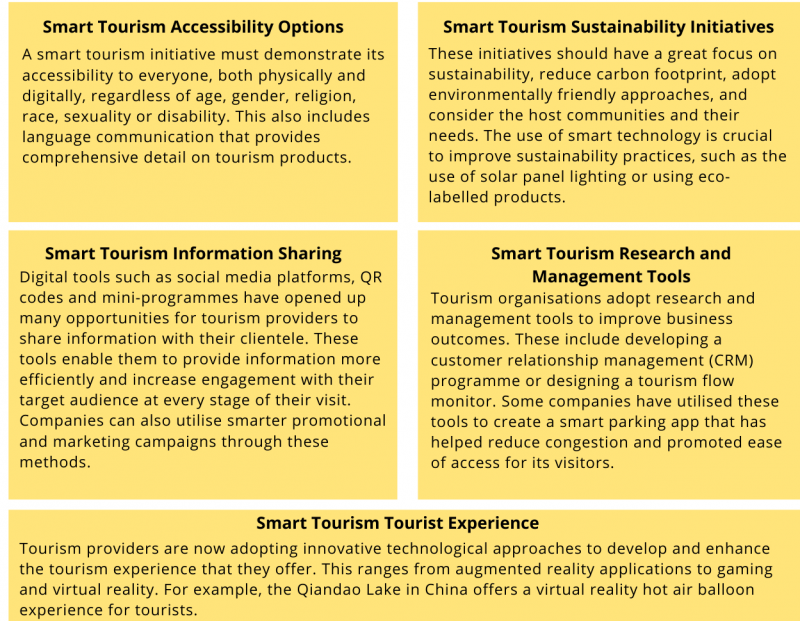
While the tourism sector has taken a hard blow due to the pandemic, the focus on digitalisation and developing smart products and infrastructure are among initiatives to build a more resilient and sustainable future in Malaysia. Taking a positive spin, a crisis is often an opportunity to rethink and reinvent old processes, particularly to adopt more sustainable tourism practices. According to UNWTO (UN World Tourism Organisation), sustainable tourism ‘has the potential to advance urban infrastructure and universal accessibility, promote the regeneration of damaged areas and preserve cultural and natural heritage, assets that depend on tourism’.
In recent years, there has been a demand for high-class hotel development in response to the increase in global wealth and higher living standards among developed and developing countries. The upcoming mega projects and large mixed-use development in TRX, Bandar Malaysia and KL Metropolis are expected to attract upperupscale and luxury hotels. It is estimated that the proposed investment for the establishment of 4 and 5 star hotels in Malaysia amounted to RM7 billion in 2021.
In efforts to develop Malaysia’s tourism landscape into a sustainable, competitive and resilient sector, incentives are provided to encourage existing operators of 4 and 5-star hotels and smart tourism. MIDA welcomes quality investments that involve high-value and innovative tourism products and services, and contributes to a comprehensive ecosystem such as special tourism investment zones without compromising on environmental policies and legal requirements. MIDA also encourages companies to invest in modern and higher standard infrastructure and facilities to build up the resilience and long term competitiveness of the tourism sector.
Explore other related content to further explore MIDA’s insights.
- Events & Activities
- Media Releases
News & Media
- Our Programmes
- Shared Articles by Mega Fam Participants
- Submit Your News
- Travel Media Buddy
- Share this article
TOURISM MALAYSIA UNVEILS STRATEGIC ROADMAP FOR VISIT MALAYSIA 2026
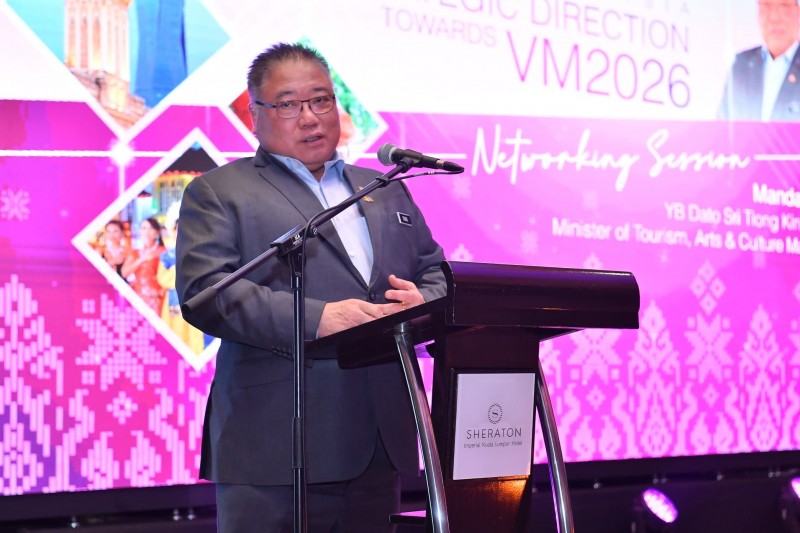
YB Dato Sri Tiong King Sing, Minister of Tourism, Arts and Culture delivering his mandate at the Tourism Malaysia Strategic Direction Towards VM2026 Networking Session
KUALA LUMPUR, 30 April 2024 – Tourism Malaysia had a prominent start on 30th April 2024 by organising a networking session with the industry players by presenting its strategic direction and action plans focussing on promoting Malaysia internationally and domestically. This direction and action plans were crafted during the engagement session with industry players to ensure the fast conversion and high impact programme and achieve the common goal in attracting 35.6 million tourists and generate RM147.1 billion in receipts for Visit Malaysia 2026.
The VM 2026 roadmap is built on three core strategies – creating demand, increasing traffic, and prioritising target markets. Key initiatives include branding and marketing blitz, strategic partnerships for joint promotions/tactical campaigns and market segmentation.
Malaysia's notable tourism achievements for the first quarter of 2024 are promising. During this period, from January to March, Malaysia saw a significant influx of foreign tourists, reaching 5.8 million arrivals. This marks a remarkable growth of 32.5% compared to the previous year's 4.3 million. The top ten markets contributing to this success were Singapore, Indonesia, China, Thailand, Brunei, India, South Korea, the United Kingdom, Australia, and the Philippines.
Tourism Malaysia will continue to empower its branding through aggressive advertising campaigns, influencer marketing, and compelling content creation across digital (70%) and traditional (30%) media platforms. The agency will also establish strategic partnerships with airlines, online travel agents (OTAs), and land/sea border operators of neighbouring countries to enhance tourist arrivals.
Key target markets are prioritised into three tiers, led by first-level priorities such as China, India, Indonesia, Vietnam and Australia. The second-level priorities include South Korea, Gulf Cooperation Council (GCC) countries and the United Kingdom, followed by third-level priorities comprising Chinese Taipei and Germany. Apart from traditional markets such as Brunei, Thailand and Singapore, the focus is also highlighted on emerging markets like Pakistan and Bangladesh.
Meanwhile, tourism products and travel experiences will be tailored for niche segments like nature-based tourism, experiential tourism, medical & wellness tourism, responsible tourism, luxury, weddings, Muslim-friendly, gastronomy, and bleisure travel.
YB Dato Sri Tiong King Sing, Minister of Tourism, Arts and Culture, said: "Our multipronged VM 2026 strategy provides a comprehensive framework to boost Malaysia's visibility, enhance destination accessibility and elevate our tourism offerings. Through focused efforts and strategic collaborations, we are confident of achieving our yearly arrivals and target receipts in the run-up to VM 2026."
Tourism Malaysia will continue engaging industry stakeholders and international partners to refine and execute the VM 2026 strategies, positioning Malaysia as a preferred tourist destination in this region.
About Tourism Malaysia
Malaysia Tourism Promotion Board, also known as Tourism Malaysia, is an agency under the Ministry of Tourism, Arts & Culture Malaysia. It focuses on the specific task of promoting Malaysia as a preferred tourism destination. Since its inception, it has emerged as a major player in the international tourism scene.
The next Visit Malaysia Year, set to take place in 2026, will commemorate the sustainability of the nation's tourism industry, which is also in line with the United Nations Sustainable Development Goals (UNSDG).
Furthermore, Tourism Malaysia actively endorses the Indonesia-Malaysia-Thailand Growth Triangle (IMT-GT), working towards the realisation of the IMT-GT Visiting Year 2023-2025, with the shared aim of promoting the region as a unified tourism destination. For more information, visit Tourism Malaysia’s social media accounts on Facebook , Instagram , Twitter , YouTube , and TikTok .
For enquiries, please contact:
Mohamed Shahrir Hadzim Deputy Director Strategic Planning Division [email protected] Tel: +603 8891 8164
Marhafizman Mohamad Daud Senior Tourism Officer Corporate Communications Division [email protected] Tel: +603 8891 8755
Related Photos
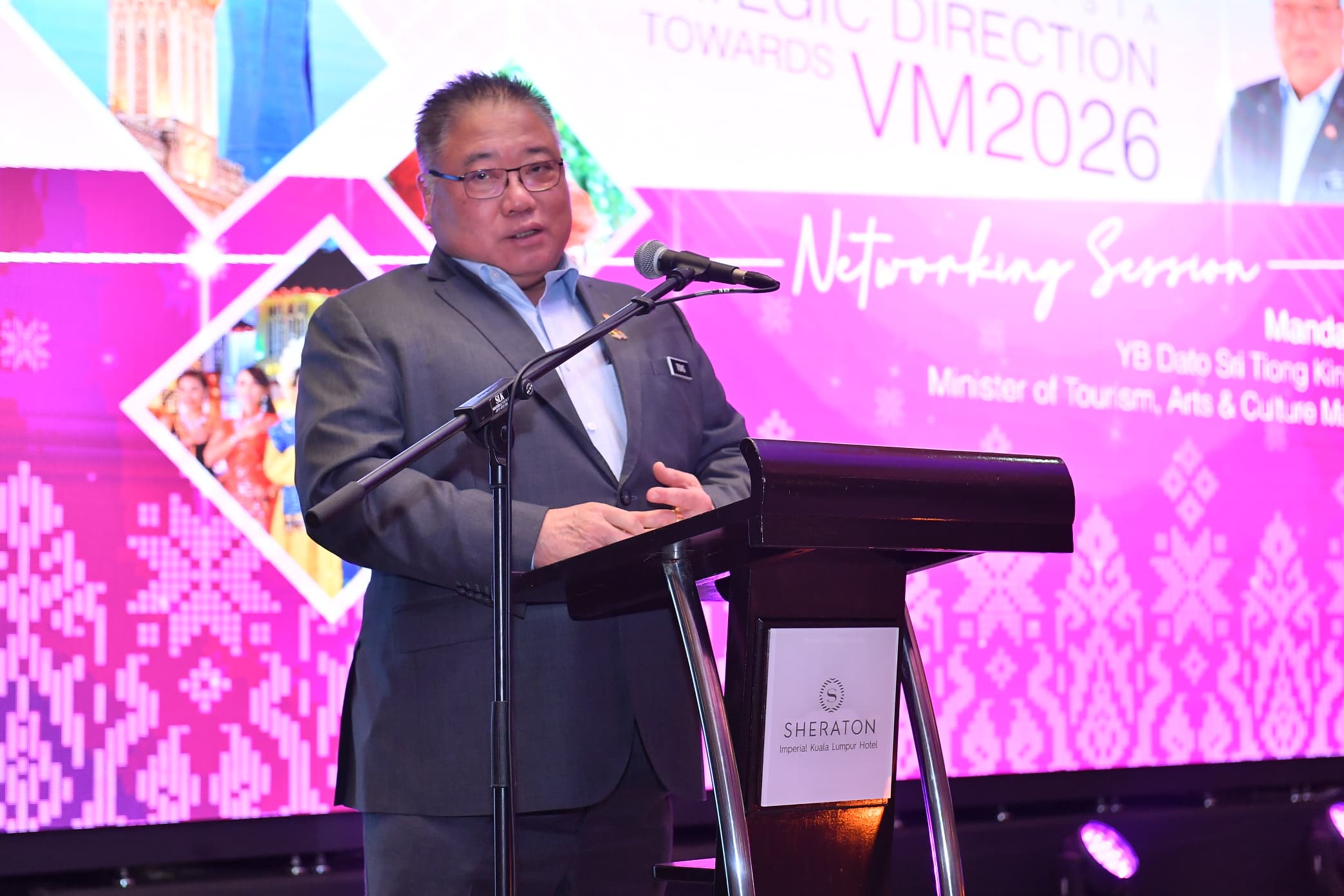
Academia.edu no longer supports Internet Explorer.
To browse Academia.edu and the wider internet faster and more securely, please take a few seconds to upgrade your browser .
Enter the email address you signed up with and we'll email you a reset link.
- We're Hiring!
- Help Center

Issues of Safety and Security: New Challenging to Malaysia Tourism Industry

2014, SHS Web of Conferences
Related Papers
Dr. Ahmad AlBattat
The repeated kidnapping incidents in Sabah had negatively impacted Malaysia's tourism sector, especially in the number of tourist arrivals. An immediate survey with international tourists upon their perceptions toward the embedded risks visiting Sabah after six months of the incidents had been conducted. A total of 224 complete questionnaires were collected. The results showed unexpected findings that the respondents do not have a strong life-threatening perception on Sabah. The correlations of safety perception and precaution taken during the traveling were not statistically significant. The major reason is that tourists view the incidents as transitory and independent of tourism activity. This study further shows the pattern of risk tolerance with different tourists' behavioral and demographic profiles. Multivariate regression was conducted to examine the major determinants of tourists' risk perception. Ultimately, the study provides useful implications toward the sustainability of the tourism industry over a crisis period.
9th Asia Pacific Forum for Graduate Students’ Research in Tourism
Anshul Garg
Baizura Bookhari , Noor Azah Aziz
In recent years, safety aspect becomes one of the prominent issues among tourists in the urban tourism. This issue has led to the implementation of Safe City Programme in Putrajaya since year 2004. Local tourists have been selected as the main respondents in this research. While Safe City Programme has been implemented in Malaysia, respondents believe that crime prevention steps in Safe City Programme are important approach to ensure the tourist’s safety. However, if a measure from the effectiveness, a majority of respondents has preferred the “satisfied” to presume a level of crime prevention steps under Safe City Programme in Putrajaya.
The purpose of this research is to examine the relationship influencing factors and tourist perception on safety in Kelantan. The main objective for this research is to investigate the factor influence tourist perception on safety in Kelantan. It is discovered media influence; risk perception and destination image that affected the number of tourists’ arrivals for tourism industries. The number of local tourist arrival in Kelantan in 2019 was 6.5 million were targeted respondents and a total of 227 respondents who were successfully founded were questioned through the online survey. The data was collected and analysed by using Statistical Package for Social Science (SPSS) version 25.0. Pearson correlation coefficient was used in this research to investigate the relationship between media influence, risk perception and destination image. The result shows a significant relationship between media influence, risk perception and destination image with the tourist perception on safety. Thr...
Sohela Mustari
Malaysia perhaps one of the most unique countries of the world, being strategically situated on the gate-way location of global routes with a wonderful eco-environmental setting. Being a pluralistic sosiety, Malaysia inherits its own traditional culture with harmonious integration of the diverse ethnic groups living in a very peaceful and politically stable situation. With the all its economic potentials, Malaysia has recently emerged as a newly-developed nation with a huge infrastructural growth in its industrial and manufacturing sectors. Due to these developments aand other eloquent features, people from abroad become largely attracted to this land and thus, they frequently arrive here as visitors and tourists. As recently as in the year 2005, it is reported that at least 16.7 million international tourists from outside visited Malaysia bringing about 30 billion ringgit in terms of foreign currency in this country. It brings civic pride and social prestige for Malaysia by making ...
23rd International Scientific Conference on Economic and Social Development Proceedings
Petar Kurecic
The paper represents a product of mentor-graduate student cooperation, developed at the graduate study of Business Economics, major Tourism. Following the latest threatening events and having in mind those yet to come, we can conclude that no country can benefit from the tourism industry if at the same time does not develop its security system as an integral part of the standard tourist offer. Analyzing the trends in contemporary tourism, the safety and security issues became the decisive factors for the choice of a certain destination. Consequently, countries must not perceive security systems and measures as an unnecessary expense but as an essential element in organizing their tourist services. All hotels and respectable tourist agencies should have a crisis management, with detailed, thoroughly elaborated procedures for emergency situations. Tourists should be timely informed about the potential dangers and risks and the measures taken to prevent them, as well as on procedures for emergency situations. Additionally, it would be good to have mobile applications that would enable tourists to make direct emergency calls with instructions on behavior in crisis situations. It is also essential to implement and put into effect sophisticated security measures such as using surveillance cameras, controlling access to buildings, information exchange with colleagues and neighbors, reporting the suspicious occurrences to the security services, and training staff for crisis management. Having in mind everything stated above, the security issue is definitely one of the crucial factors in the development of tourism in a certain country.
Annals of Tourism Research
Johan Fourie
Liliana Popescu
For many countries, tourism is considered as having a great economic importance, with quite a large share in the country’s GDP. Hence, the number of foreign tourists is highly important. But worldwide, the threats and dangers are more frequent, and consequently tourists are becoming more aware of the necessity of a safe destination. Foreign tourists are educated in the spirit of touristic safety, and when choosing a particular destination, this aspect is of utmost importance. The image of the country or any touristic destination depends on the quality of the touristic products, which include not only the natural and cultural patrimony or the economic environment, but also the social and political climate, state order and citizens’ safety. A country with a good image for safe tourism can use it as a competitive advantage and attract different segments of the international tourism market. The paper presents some of the safety issues in tourism, focusing on the main aspects of tourism safety in Romania, based on the travel and tourism competitiveness index, with special focus on the third pillar – Safety and Security and the results of an on-line survey with managers and employees in tourism activities.
Journal of Tourism, Hospitality and Environment Management
Siti Hajar Zakariah
Safety practices of tourism products have been a huge reason to choose from. Lacking of good safety practices might become disadvantages for the tourism industry. This study aims to examine the perception of local tourists on the safety practices applied by the tourism industry. The perception has been examined on the three aspect, (1) safety practices in terms of accommodation; (2) safety practices in terms of accessibility; and (3) enforcement practices by local authorities. A total of 30 respondents consists of local tourists that visited Malacca City were involved. Descriptive analysis of mean and percentage was employed to test the objectives. The results showed that local tourists were concerns of the accommodation quality with mean of 4.03, make sure the vehicles were safe to access with mean of 3.97 and local tourist feel safer with local enforcement with mean of 4.06. Undeniable the safety practices of the tourism industry do give popular concerned among the local tourists.
RELATED PAPERS
Diabetes Care
Yiling Cheng
Revista Psicológica Herediana
Amigo Secreto
Randheer Singh
El genio maligno. Revista de Humanidades y Ciencias Sociales
Ana M. Muñoz-Muñoz
Dina Mohamed
Agustin Vera
Crisis económica y nueva …
José Antonio Alonso
Stéphane Amato
gabriela beatriz suarez fiestas
Econometrics
Rocco Mosconi
Louis Matis
AAPS PharmSciTech
Muchamad Iksan
Celebes Abdimas: Jurnal Pengabdian Kepada Masyarakat
nirmawana simarmata
Brazilian Journal of Health Review
Felipe César Andrade
2006 International Telecommunications Symposium
Rafael Pasquini
Business and Management Horizons
Rayhan Islam
Indonesian Journal of Legality of Law
Muhammad Aksan
Journal of Laser Applications
frederic coste
Proceedings of the Water Environment Federation
Tony Donigian
澳洲假文凭办理Melb Uni毕业证书 买墨尔本大学毕业证成绩单,
Reinas de la música
María Cáceres Piñuel
Mediterranean Journal of Nutrition and Metabolism
Leonardo Masselli
Revista Colombiana De Ciencias Quimico Farmaceuticas
Daniel jofre delgado
Kathryn Boyce
- We're Hiring!
- Help Center
- Find new research papers in:
- Health Sciences
- Earth Sciences
- Cognitive Science
- Mathematics
- Computer Science
- Academia ©2024

- The Star ePaper
- Subscriptions
- Manage Profile
- Change Password
- Manage Logins
- Manage Subscription
- Transaction History
- Manage Billing Info
- Manage For You
- Manage Bookmarks
- Package & Pricing
S'wak keen to pursue tourism autonomy talks with Putrajaya
- Sabah & Sarawak
Thursday, 09 May 2024
Related News

Sabah registers solid tourism numbers in first three months of 2024, says Liew
Measures proposed in special meeting to prevent paragliding accidents in sabah, rm1bil for 224 infrastructure projects in sabah.
Sarawak Legislative Assembly. -Zulazhar Sheblee/The Star
KUCHING: Sarawak is waiting for the Sabah government to finalise its stand on whether or not tourism should be included in the concurrent list in the Federal Constitution before negotiating further with Putrajaya on the matter.
State Deputy Tourism, Creative Industry and Performing Arts Minister Datuk Sebastian Ting said the Sarawak government was consistent in its stand that the Constitution should be amended to move tourism from the federal list to the concurrent list in the Ninth Schedule.
However, he said the Sabah government had proposed instead that tourism be taken out from the lists in the Ninth Schedule and remain a residual matter.
"A further discussion between the state attorney generals' chambers of Sarawak and Sabah was initiated on Oct 13 last year to finalise the stand.
"We are waiting for the Sabah government to finalise its stand before this matter can be brought up to the federal Tourism, Arts and Culture Ministry and subsequently to the technical committee of the Malaysia Agreement 1963 (MA63) chaired by the Deputy Prime Minister for further action," he told the Sarawak Legislative Assembly during question time on Thursday (May 9).
Ting said the Sarawak government remained committed to pursue and safeguard the state's special rights and position as enshrined in MA63, as well as Sarawakians' aspirations for greater autonomy.
With tourism in the concurrent list, he said, Sarawak would have the authority to make its own laws relating to tourism.
He said this included matters such as promoting investment in tourism businesses; developing human resources; improving state management of the sector; facilitating community-based and cross-border tourism; and collecting tourism tax.
He said the state would also be able to issue licences and approvals for tourist guides, the Sarawak-Malaysia My Second Home programme, homestays, tourism training institutions and tourism vehicles.
Tags / Keywords: Sarawak , Sabah , Tourism , Concurrent List , Federal Constitution , Sebastian Ting , MA63 , Autonomy , Laws
Found a mistake in this article?
Report it to us.
Thank you for your report!

IGNITING STEM PASSION
Next in nation.

Trending in News
Air pollutant index, highest api readings, select state and location to view the latest api reading.
- Select Location
Source: Department of Environment, Malaysia
Others Also Read
Best viewed on Chrome browsers.

We would love to keep you posted on the latest promotion. Kindly fill the form below
Thank you for downloading.
We hope you enjoy this feature!

IMAGES
VIDEO
COMMENTS
Source: Strategic Planning Division, Tourism Malaysia with the cooperation of Immigration Department, Malaysia Malaysia has recorded 10,070,964 tourist arrivals in 2022, a decline of -61.4% and received RM28.23 billion in tourism receipts, a drop of -67.2% compared to the same period in 2019. TOURIST ARRIVALS (MILLION) 30.00 25.00 20.00 15.00 ...
According to Tourism Malaysia, the country welcomed about 3 million visitors in 2022, a major increase from just 134,728 visitors in 2021. The 2022 intake was only about 12% of the number that arrived in 2019. However, Thailand, Singapore, and Indonesia — which in 2022 welcomed 10 million, 4.6 million, and 4.58 million visitors, respectively ...
Malaysia welcomed about 3 million visitors in 2022, up from 134,728 visitors the previous year, according to Tourism Malaysia. The intake was just about 12 percent of the number that arrived in ...
In 2019, before Covid-19 shut down all travel, Malaysia received 26.1 million international visitors who brought in RM86.1 billion in revenue, according to Tourism Malaysia statistics. Hiking is ...
In Malaysia, the number of women working in the tourism industry dropped by more than 2% to 48.3% in 2020, compared to 50.3% in 2019, and the Malaysian government has announced that the 2022 gender-balanced budget will benefit women in tourism equally.
In late December 2020, the Prime Minister of Malaysia launched Malaysia's National Tourism Policy 2020-2030, giving concrete direction for the future of Malaysia's tourism industry over the next ten years. In his speech, the Prime Minister emphasised the importance of recovery, connections, and s
National Tourism Policy 2020-2030 In response, the Government launched the National Tourism Policy (NTP) 2020-2030 on 23 December 2020 to ensure the continuity of the country's tourism industry, while targeting to make Malaysia a global top 10 tourism destination in both arrivals and receipts.
Current Issues in Tourism Volume 24, 2021 - Issue 19: COVID-19 and Tourism. Submit an article Journal homepage. 183,269 Views 155 ... The pandemic is highly impacting the tourism industry in Malaysia, particularly, the airline and hotel businesses. Apart from that, this study also discusses the stimulus packages offered by the Malaysian ...
Tourism Malaysia Strategic & Marketing Plan was developed based on National Tourism Policy 2020-2030, National Ecotourism Plan 2016-2025, National Cultural Policy (DAKEN) 2021 and UNWTO Sustainable Development Goals (SDGs). The strategies are also formulated on market trends and sentiments, secondary data research as well as input from ...
Malaysia Tourism Key Performance Indicators 2020. The closure border and the implementation of Movement Control Order since 18th March 2020 to curb further outbreaks of COVID-19 in the country has restricted the movement of travellers. In total, Malaysia received 4,332,722 international tourists arrival a decrease of (-83.4%) compared to same ...
UNWTO's World Tourism Barometer indicated that tourism arrivals fell from 1.47 billion in 2019 to 399 million in 2020, signifying a 74.0 per cent decrease worldwide. Prior to the pandemic, Malaysia's economy was highly dependent on tourism, which was the third largest contributor to national GDP at the time, after manufacturing and commodities.
According to Prime Minister Tan Seri Muhyiddin Yassin, this has caused Malaysia's projected GDP growth for the year to shrink by 0.8 to just 1.2 points, with a potential loss of RM 17.3 billion ...
PETALING JAYA, Nov 14 — The Covid-19 pandemic has significantly influenced the global tourism industry. Here in Malaysia, the income of local business owners was severely impacted by lockdowns including the movement control order (MCO) and the closing of borders to stop the spread of Covid-19. Since reopening of the economic sectors, the ...
Nonetheless, what was once a thriving sector of Malaysia's economy, contributing around 6.8 percent to the Gross Domestic Product (GDP) in 2019, the tourism industry suffered the consequences of ...
Tourism Influencers. In the aftermath of the pandemic, the Malaysian travel industry is experiencing a renaissance, propelled by travel content creators who use social media platforms to showcase the diverse and captivating tourism attractions across the country. Nur Aina Yusob, 28, a travel content creator widely recognised as @ainayb, noted a ...
Monday, 13 Feb 2023 7:34 AM MYT. BINTULU, Feb 13 — The tourism industry is seen as one of the best measures to restore the country's economy, said Tourism, Arts and Culture Minister Datuk Seri Tiong King Sing. The Bintulu MP said for that purpose, every player in the tourism industry such as hotel operators, restaurants, shopping centres ...
Prevent the abuse of visa-free entry. Tourism Malaysia to promote our many idyllic beaches. Easing congestion at KLIA. Malaysia records 26 million tourist arrivals from Jan 1 to Nov 15, says ...
Based on the literature reviewed, the findings on the challenges and issues faced by the tourism industry in Malaysia amid the Covid-19 pandemic are mostly in line with previous research. The reduction of tourist arrivals, supply-demand mismatch, underemphasis on domestic tourism, and lack of resilience have been identified as major challenges ...
Tourism is the third-largest contributor to Malaysia's GDP, after the manufacturing and commodities sectors. In 2019, the sector contributed about 15.9 per cent to the total GDP. In the last few years before the outbreak of COVID-19, the tourism industry in Southeast Asia had experienced a significant growth phase, and Malaysia launched the "Visit Truly Asia Malaysia 2020" campaign with ...
The tourism industry contributed a significant 2.4% increase in tourism receipt from RM82.1 billion (2017) to RM84.1 billion in 2018 (Tourism Malaysia Statistic, 2018). To speed up the development of the tourism industry, the government has spent more of its budget to invest in improving hospitality since tourism needs skillful manpower to ...
ALOR STAR: The lack of a robust tourism branding campaign is the main reason why visitors from Thailand are not keen to travel to Malaysia and Kedah. Kedah Tourist Guide Association president Mohd Firdaus Abu Bakar said blaming a language barrier for the lack of Thai visitors "seemed like an excuse". "We need to consider that previous tourism ...
Tourism Malaysia Strategic Plan 2022-2026. In line with the objectives and strategies of the National Tourism Policy 2020-2030 and the development of the tourism industry, Tourism Malaysia prepares its strategic direction for 2022-2026. Where a session with industry players was held, and six pandemic ponders were put forward for discussion. ...
The VM 2026 roadmap is built on three core strategies - creating demand, increasing traffic, and prioritising target markets. Key initiatives include branding and marketing blitz, strategic partnerships for joint promotions/tactical campaigns and market segmentation. Malaysia's notable tourism achievements for the first quarter of 2024 are ...
The repeated kidnapping incidents in Sabah had negatively impacted Malaysia's tourism sector, especially in the number of tourist arrivals. ... Security issues in tourism primarily refer to the personal safety of tourist and their property, but it includes an ability to become oriented in an alien environment, understand the local system of ...
Volume: 8 Issues: 53 [June, 2023] pp. 361 - 374 Journal of Islamic, Social, Economics and Development (JISED) -1755 Journal website: www.jised.com ... Tourism Malaysia Strategic and Marketing Plan was created in accordance to the National Tourism Policy 2020-2030, National Ecotourism Plan 2016-2025, National Cultural Policy ...
Ting said the Sarawak government remained committed to pursue and safeguard the state's special rights and position as enshrined in MA63, as well as Sarawakians' aspirations for greater autonomy ...
Strategic Partnership To Strengthen Malaysia's Tourism Industry For VMY2026. Tourism Malaysia and the Malaysia Aviation Group (MAG) have announced the signing of a Memorandum of Understanding (MoU) today, marking a significant step in a three-year partnership.